Editado por Luz Toledo y de Instituto de Jovel, San Cristobal de las Casas, Chiapas, Mexico.
Hace cinco años, tuve el honor de visitar el taller de Jacoba y Mária Ángeles, de San Martín Tilcajete, un pueblito en el estado de Oaxaca, Mexico.
Son artistas que tallan y pintan alebrijes, criaturas mágicas de madera. Para las artistas, que pasaba tanto tiempo creando las piezas, las criaturas tienen un espiritu dentro de ellos.
Five years ago, I had the honor to visit the workshop of Jacobo and María Ángeles, from San Martin Tilcajete a pueblo in the state of Oaxaca, Mexico.
They are artists who carve and paint alebrijes, magical wooden creatures. To the artists, who spend so much time creating the pieces, the creatures have a spirit inside them.
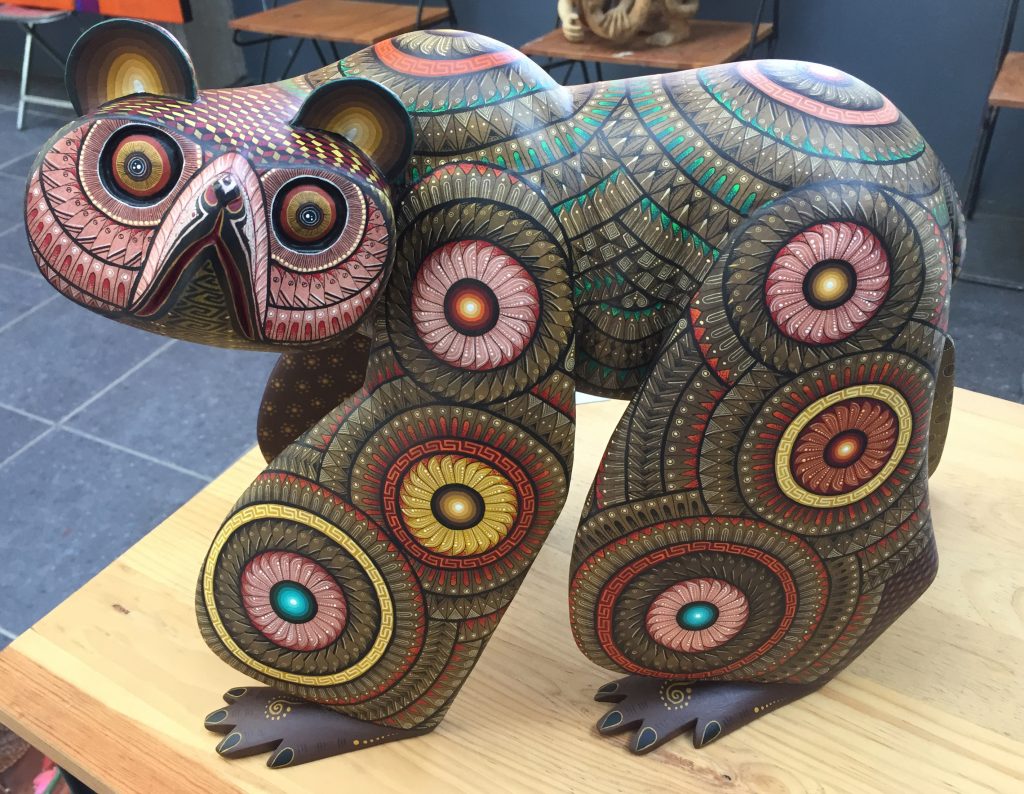
La cultura zapoteca data de antes de Cristo. Los antepasados zapotecas eran artistas, granjeros, guerreros y constructores de pirámides.
En el siglo xvi, los zapotecas fueron conquistados por los aztecas. Después, los españoles invadieron y oprimieron a los zapotecas. Sin embargo, la resistencia y la belleza de la cultura zapoteca es evidente hoy en su arte.
The Zapotec culture dates before Christ. The Zapotec ancestors were artists, farmers, warriors and builders of pyramids.
In the 16th century, the Zapotecs were conquered by the Mexicas or Aztecs. Afterwards, the Spanish invaded and oppressed the Zapotecs.. However, the resilience and beauty of the Zapotec culture is evident today in their art.
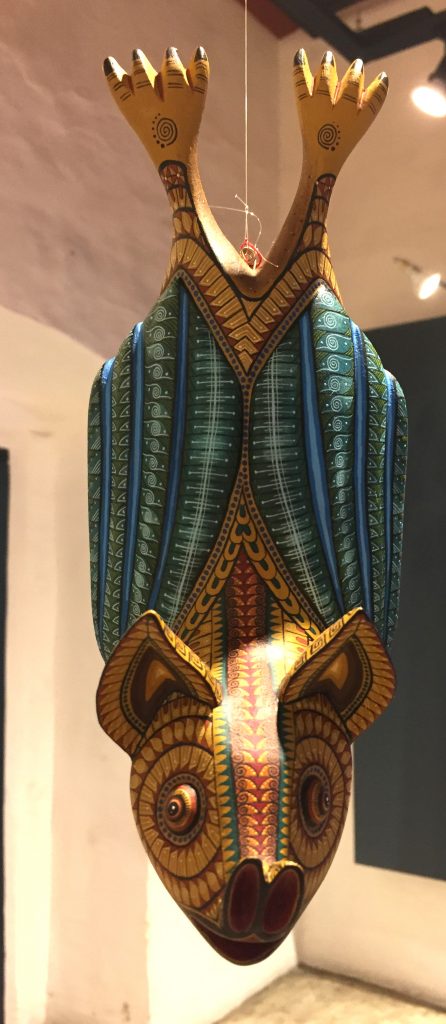
The Zapotec believed that bats or murcielago were the keepers of the Underworld.
De acuerdo con las leyendas zapotecas, algunos de sus antepasados se originaron en las cuevas y otros de los árboles, y de los jaguares.
Tambíen, otros se creyeron ser descendientes de seres sobrenaturales que vivían en las nubes. Por esto se llamaron : Be’ena’Za’a” or “la gente de las nubes”.
According to Zapotec legends, some of their ancestors originated in caves, and others came from trees or jaguars.
Still others are believed to be descended from supernatural beings who lived in the clouds. That is why they are called “Be’ena’Za’a” – “The cloud people.”
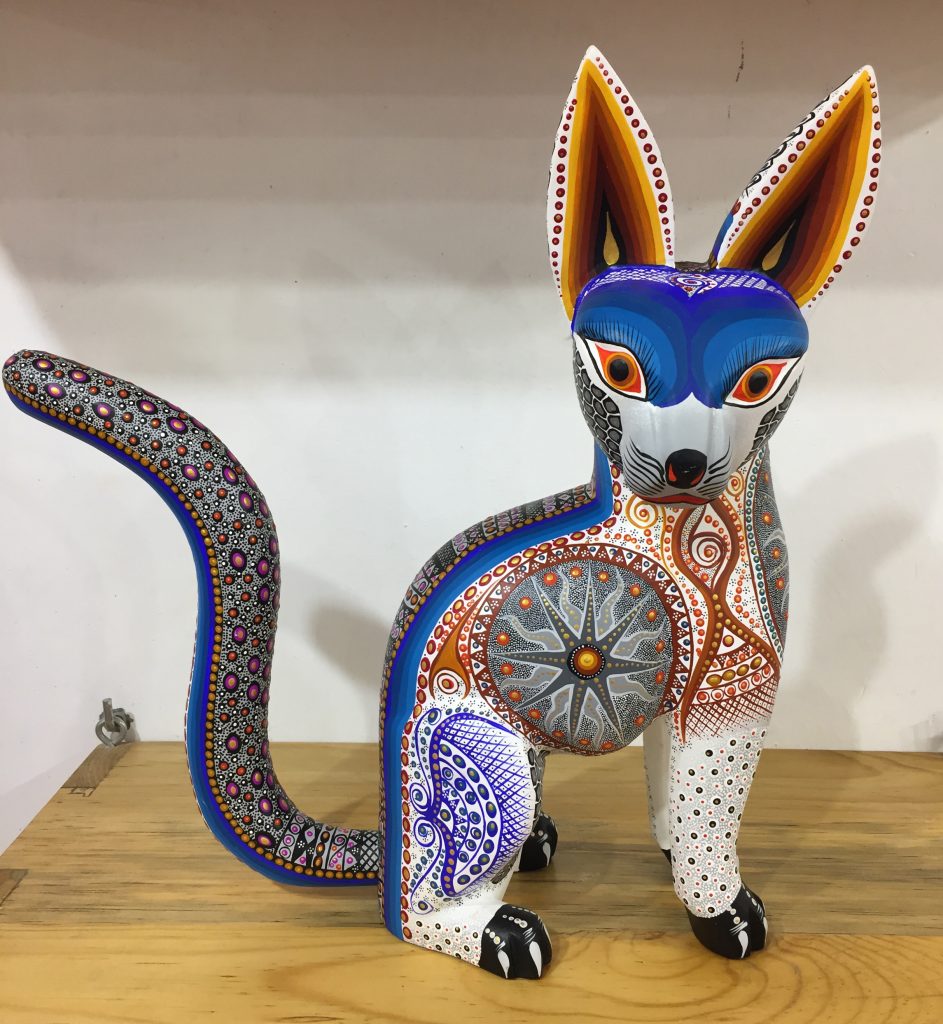
El perro sagrado del zapoteco, “Xoloitzcuintl” o Xolo, simboliza la importancia de la familia, del liderazgo positivo y del poder espiritual.
The sacred dog of the Zapotec, Xoloitzcuintli or “Xolo” symbolizes the importance of family, positive leadership and spiritual power.
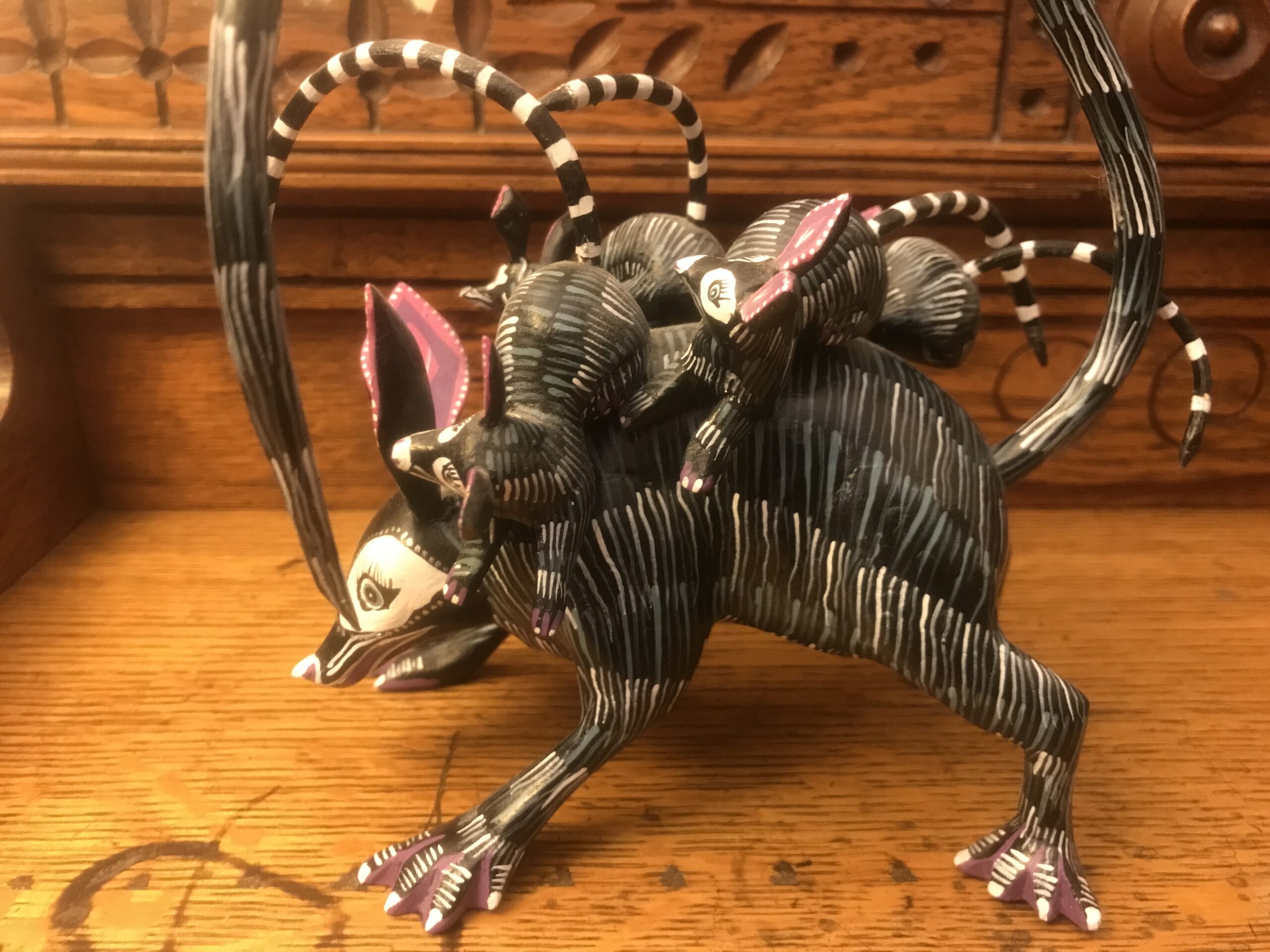 El tlacuache – possum
El tlacuache – possum
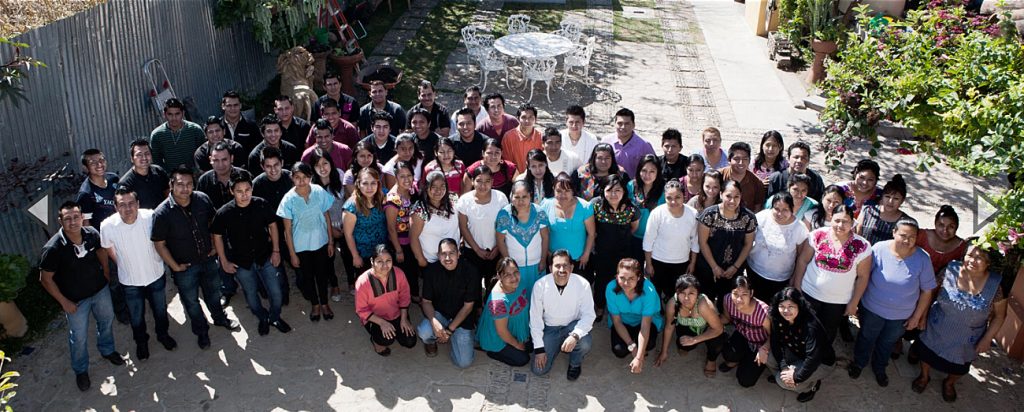
photo by Jacobo and Mária Ángeles
En el taller hay ochenta artistas y una escuela donde enseñan a los pasantes quien viven en la comunidad. El taller está dedicado a mantener viva su cultura zapoteca.
In the workshop there are eighty artists, also, a school where they teach interns who live in the community. The workshop is dedicated to keeping their Zapotec culture alive.
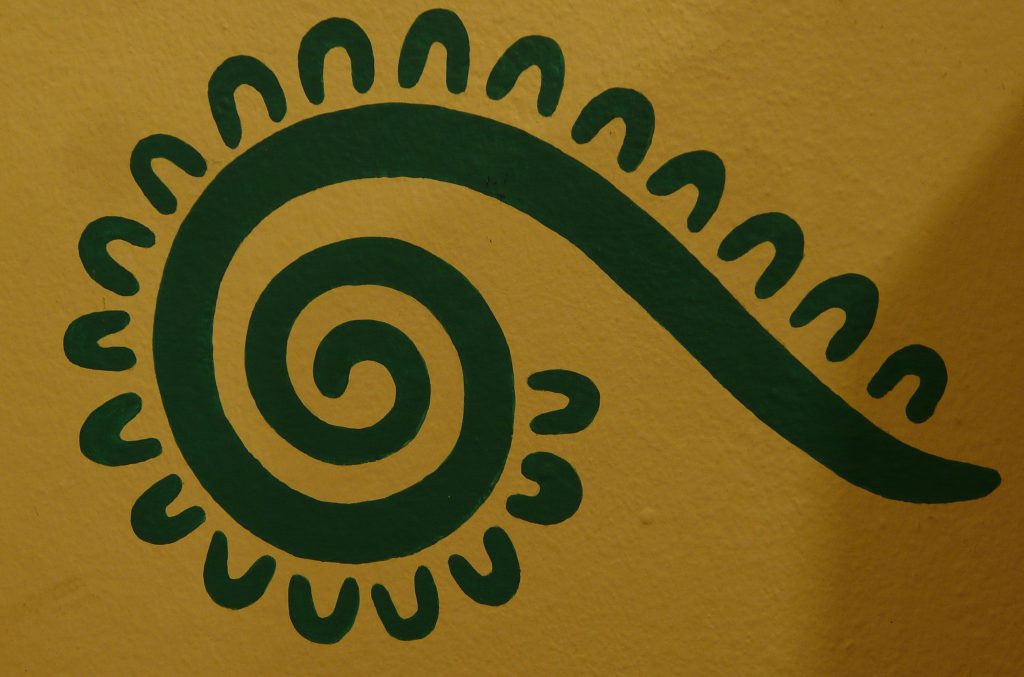
El caracol simboliza el valor de contribuir a la comunidad. Este símbolo está usado en los diseños de los alebrijes. Otros animales honrados en sus diseños son las hormigas (trabajadores) y los peces (tranquilos). De esta manera, los artistas guardan su cultura llena de vida y honran a la naturaleza.
The snail symbolizes the value of contributing to the community. This symbol is used in the designs of the alebrijes. Other animals honored in their designs are ants (hardworking) and fish (calm). In this way, the artists keep their culture full of life and honor nature.
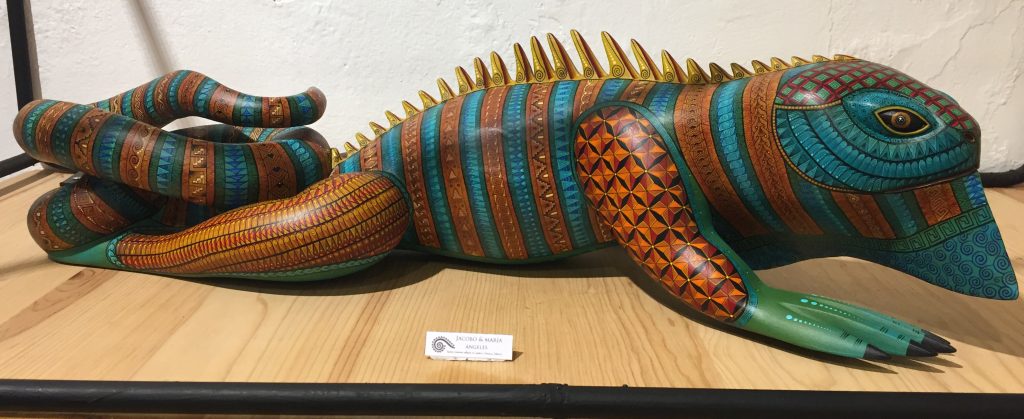
Zapotecs believed that iguanas represented creativity and sensitivity.

Photo by Jacobo Ángeles
La mayoría de los alebrijes están tallado del Copal. Es el árbol sagrado de la cultura zapoteca. Antes de empezar a trabajar, quemaron la resina del copal para ayudar a limpiar sus energía y conectado con sus antepasados. Mária Ángeles es la mujer en la imagen de la derecha. La mujer a la izquierda tiene diseñas caracol en su brazo.
Most of the alebrijes are carved from copal. It is the sacred tree of the Zapotec culture. Before starting to work, they burn the resin of the copal to help cleanse their energy and connect to their ancestors. Mária Ángeles is the woman in the image on the right. The woman on the left has caracol designs on her arm.
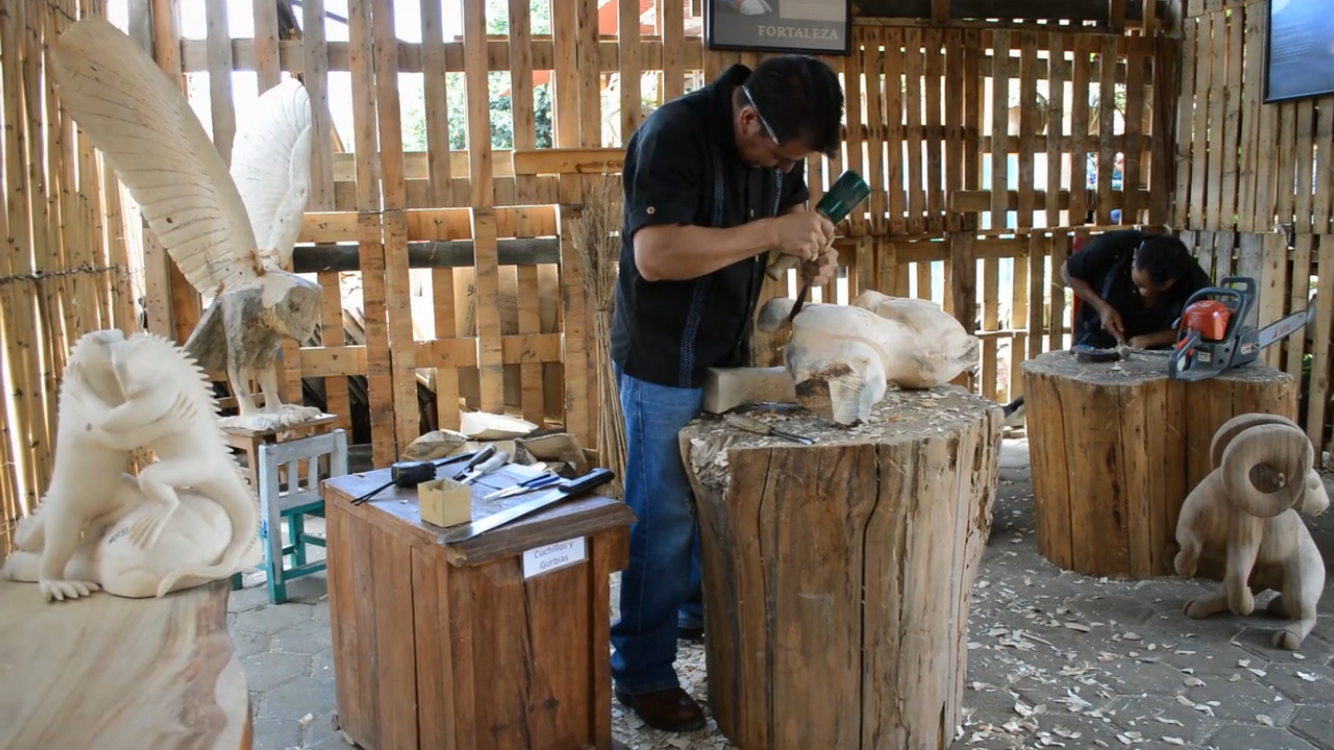
All of the work is done by hand using primitive tools: machetes, knives, and chisels. Photo by Jacobo and Mária Ángeles
Cuando un tallador comienza un proyecto, necesita estudiar la madera para encontrar el espíritu o “nahual” escondido dentro de la madera. Mientras se talla la madera, las artistas utilizan su imaginación y su habilidad con un machete.
When a carver starts a project, it is necessary to study the wood to find the spirit o nahual hidden inside the wood. While carving the wood, the artistas use their imagination and their skill with a machete.
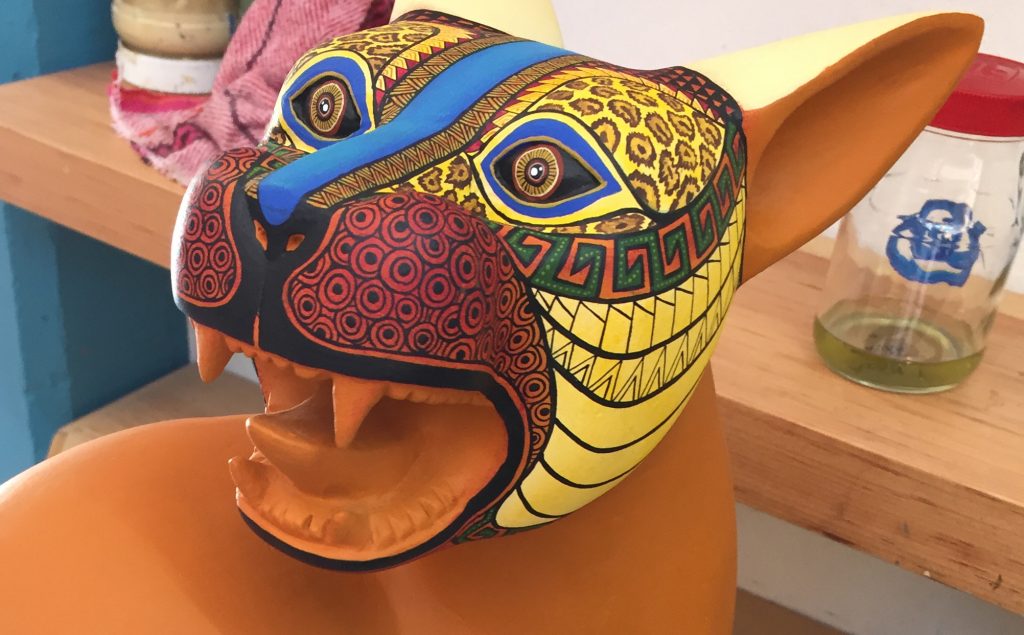
An unfinished jaguar that our guide, Elias, was working on. The entire body will be covered with Zapotec symbols. The jaguar is the protector and signifies leadership.
Nuestra guia, Elias, ha estado pintando alebrijes por veinticinco años. Él y otros artistas solo usan pigmentos natural: corteza de copal (el negro); bichos cochinillas ( el rojo); el piel de la granada (el amarillo), flores y otro materiales.
Our guide, Elias, has been painting alebrijes for 25 years. He and other artists only use natural pigments: copal bark (black), cochineal bugs (red), the skin of the pomegranate (yellow), flowers and other materials.
Los artistas pintan los diseños sin siguiente un estampado, usando su creatividad innata. Elias dijo que pintando los diseños zapoteca todo el día puede ser una experiencia meditativa.
The artists paint the designs without following a pattern, using their innate creativity. Elias said that painting the Zapotec symbols all day long can be a meditative experience.
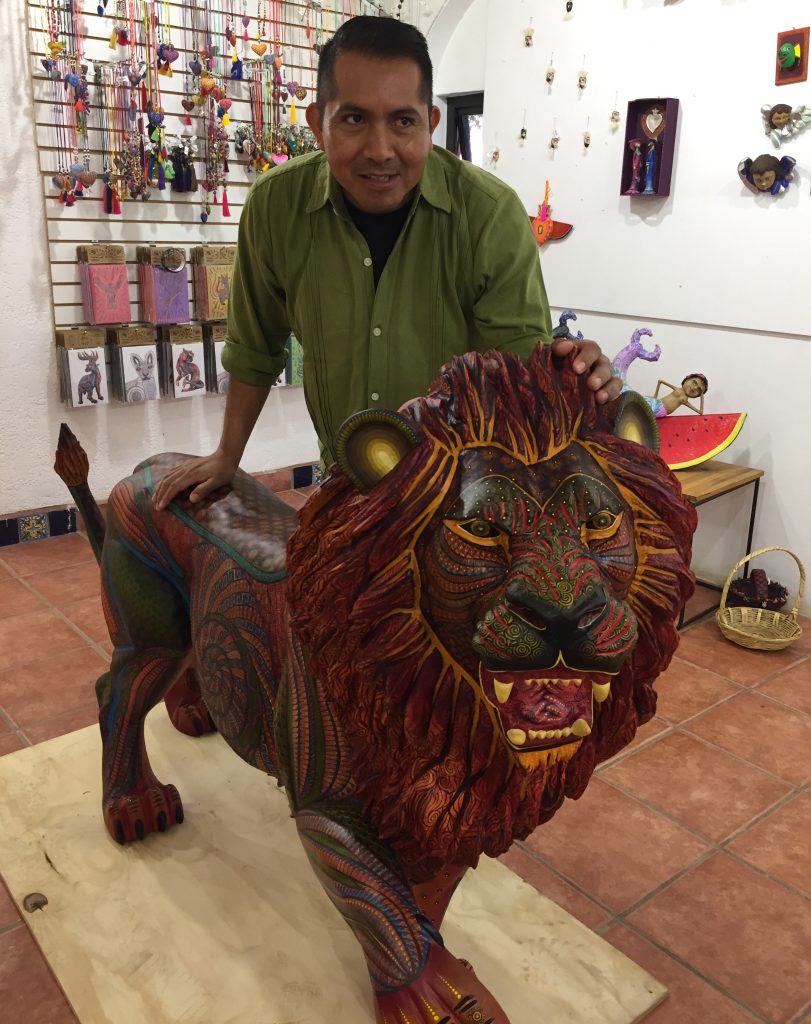
A large piece may take 1.5 years to complete from start to finish and 10 weeks to paint. Elias and a team of other artists worked together on this lion project.
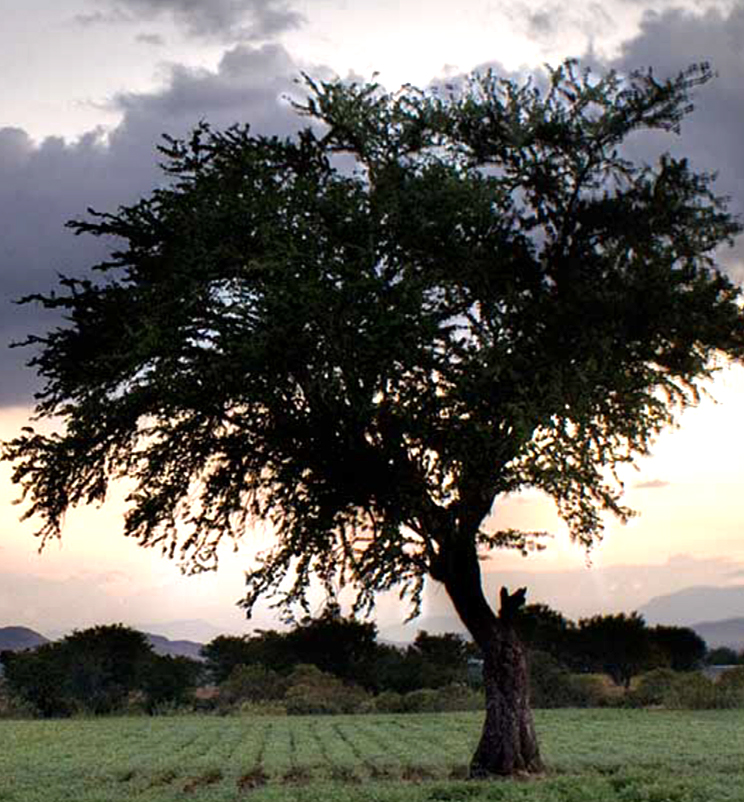
Copal Tree
photo by Jacobo y Mária Ángeles.
La resina del árbol de copal ha estado usada para incienso por más de setecientos años. Desafortunadamente, demasiados copales han sido cortados. Para garantizar la sobrevivencia de copal, el taller ha estado cultivando plántulas copales en sus viveros. Cada año, plantan tres mil plántulas en las montañas. Los árboles van a estar maduros en cuarenta años. Su visión a largo plazo garantiza que su negocio va a ser sostenible en el futuro. También, ellos estan regresando lo que tomaron de la Tierra.
The resin of the copal tree has been used for incense for more than seven hundred years. Unfortunately, too much copal has been cut. To guarantee the survival of copal, the workshop has been cultivating copal seedlings in their greenhouses. Each year, they plant three thousand seedlings in the mountains. The trees will be mature in forty years. Their long-term vision guarantees that their business will be sustainable in the future. Also, they are giving back what they took from the Earth.
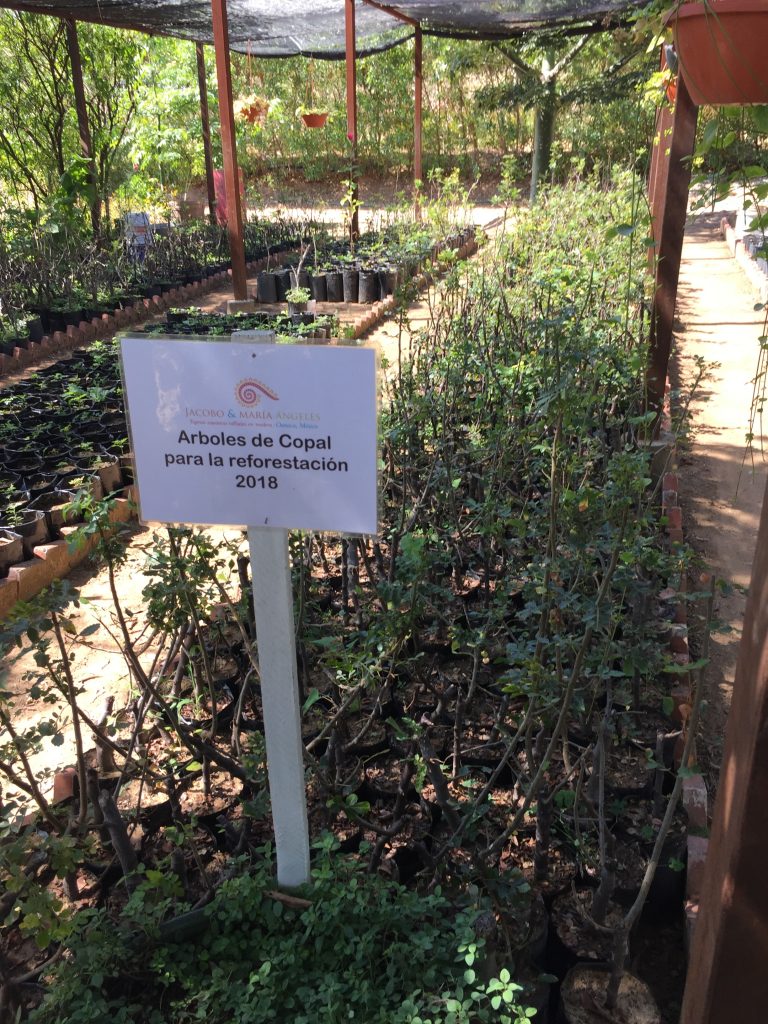
The row on the right are one year old cutting grafts. The row on the left are seedlings planted from Copal seed.
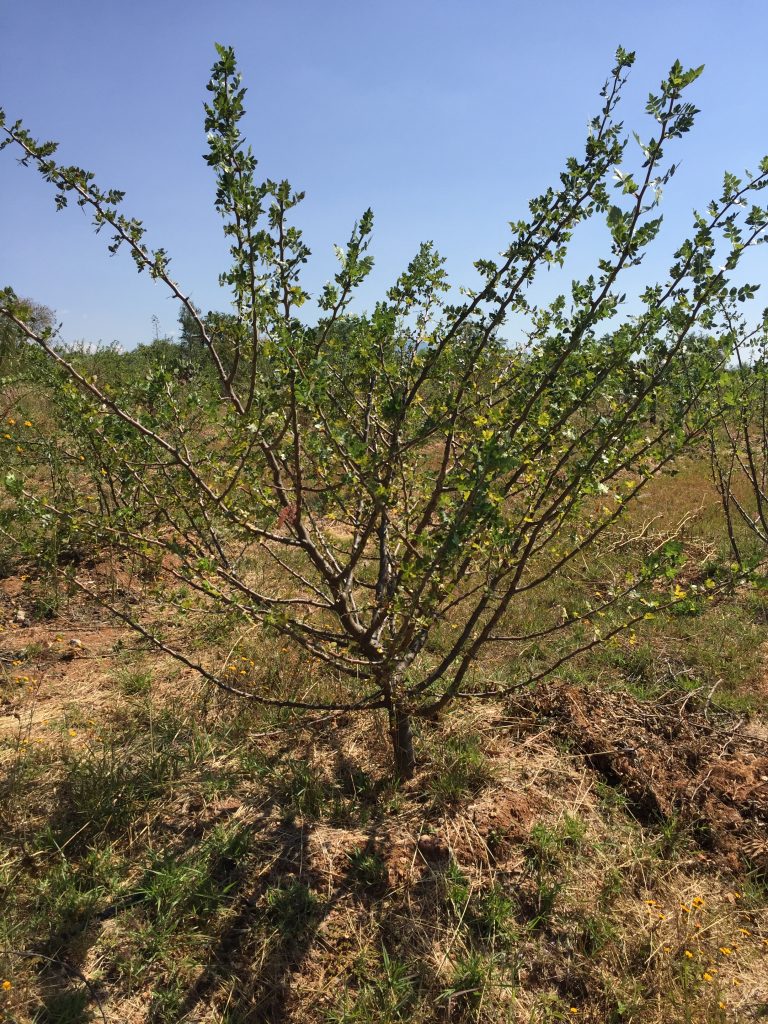
8 year old Copal Tree
Los árboles serán cosechados después de cuarenta años. En ese momento, el tronco tendrá un metro de diámetro.
The trees will be harvested after 40 years. At that time the trunk will be a meter in diameter.
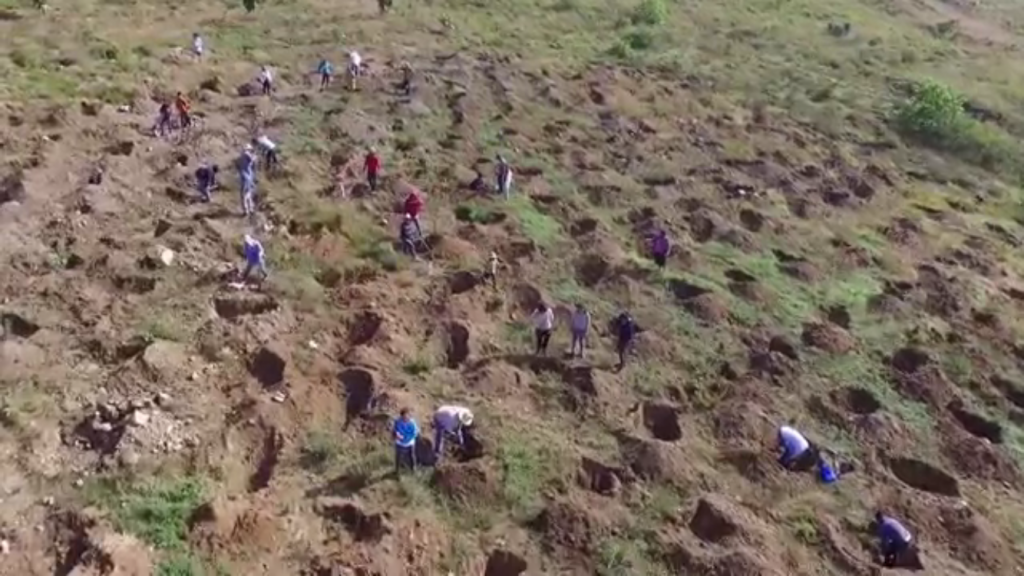
Yearly planting project that involves the entire community. photo by Jacobo y Mária Ángeles.
El taller de Jacoba y Mária Ángeles es un ejemplo positivo de qué pasa cuando los humanos siguen sus sueños y sus valores, entonces trabajan para lograrlos.
The workshop of Jacoba y Mária Ángeles is a positive example of what happens when humans follow their dreams and their values, then work to achieve them.
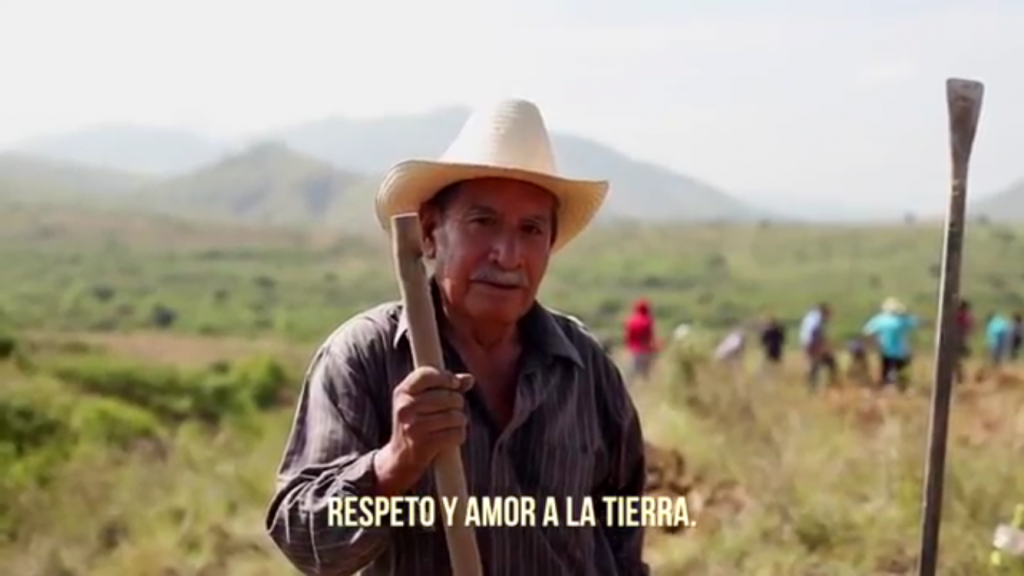
photo by Jacobo y Mária Ángeles.
Reader Jessica Blum shared the book, Dream Carver or El Tallador de Sueños para Amy Cordova














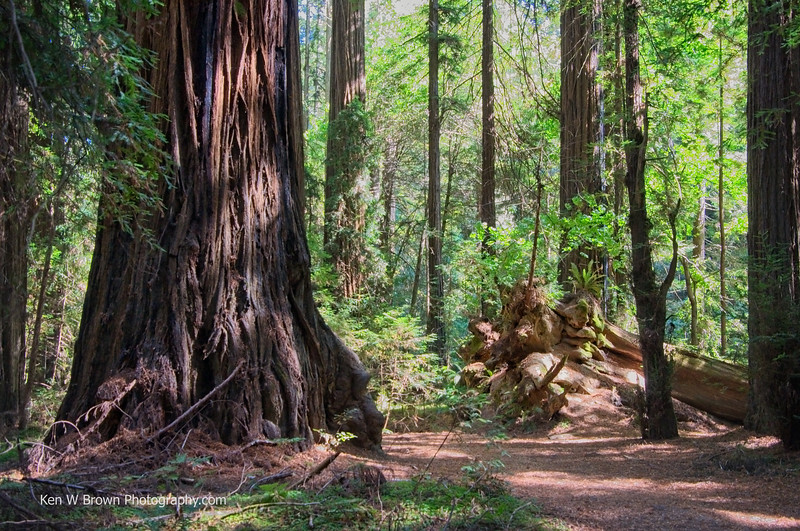
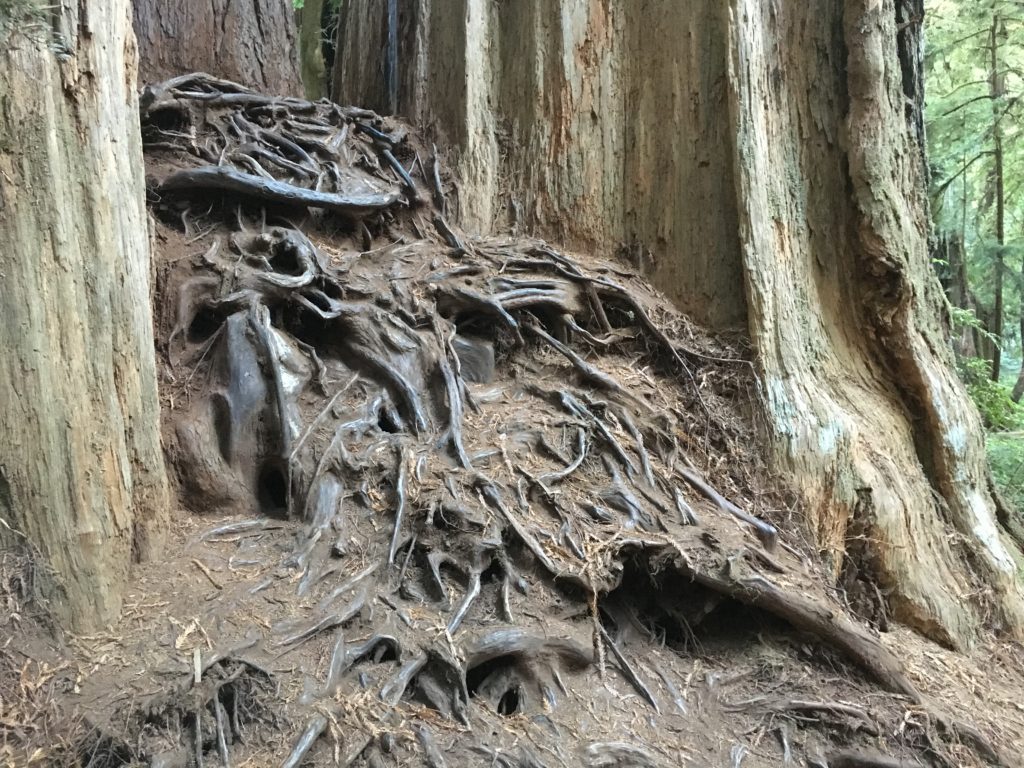
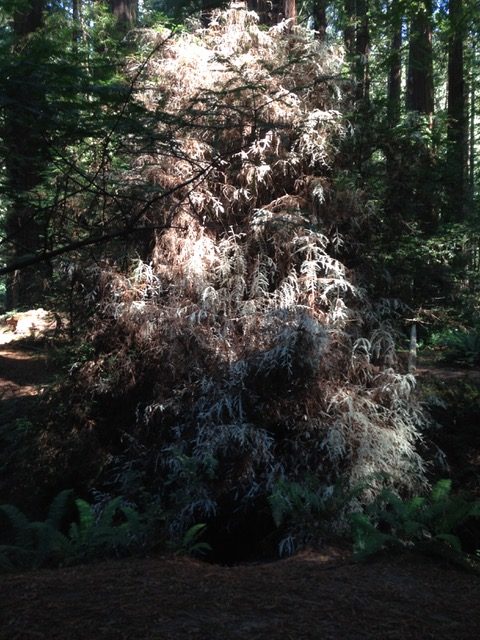
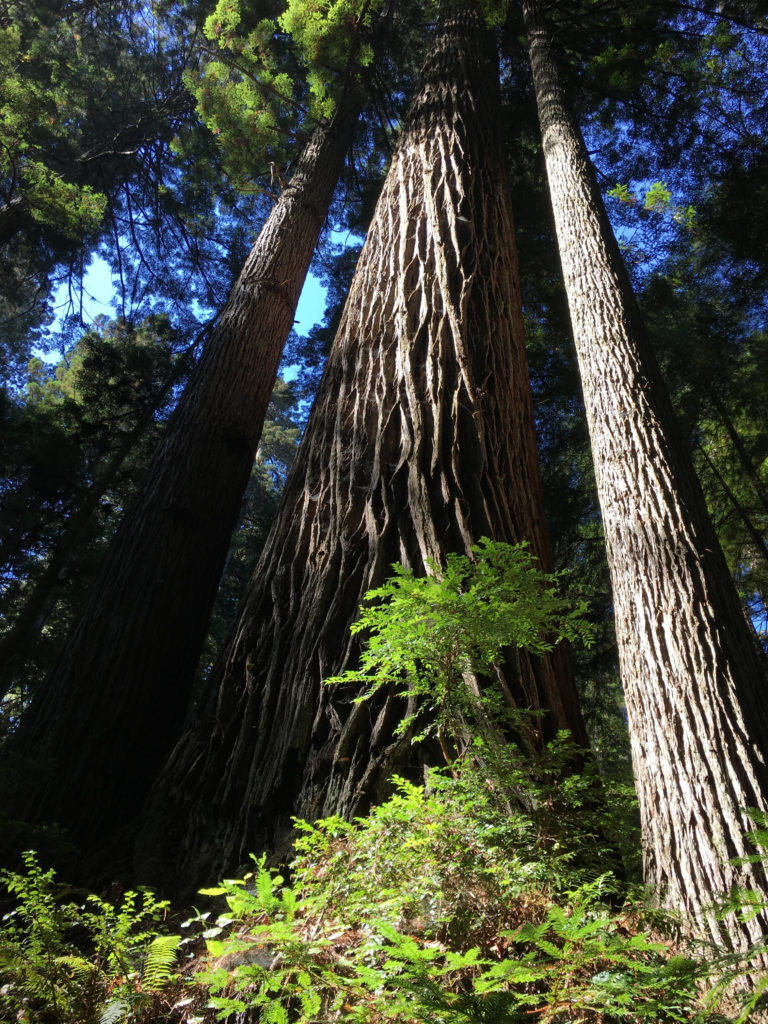
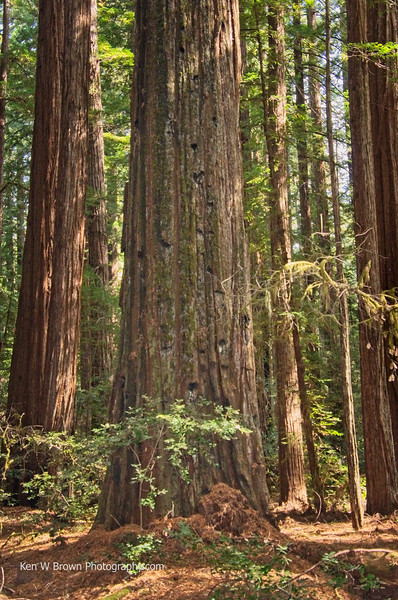
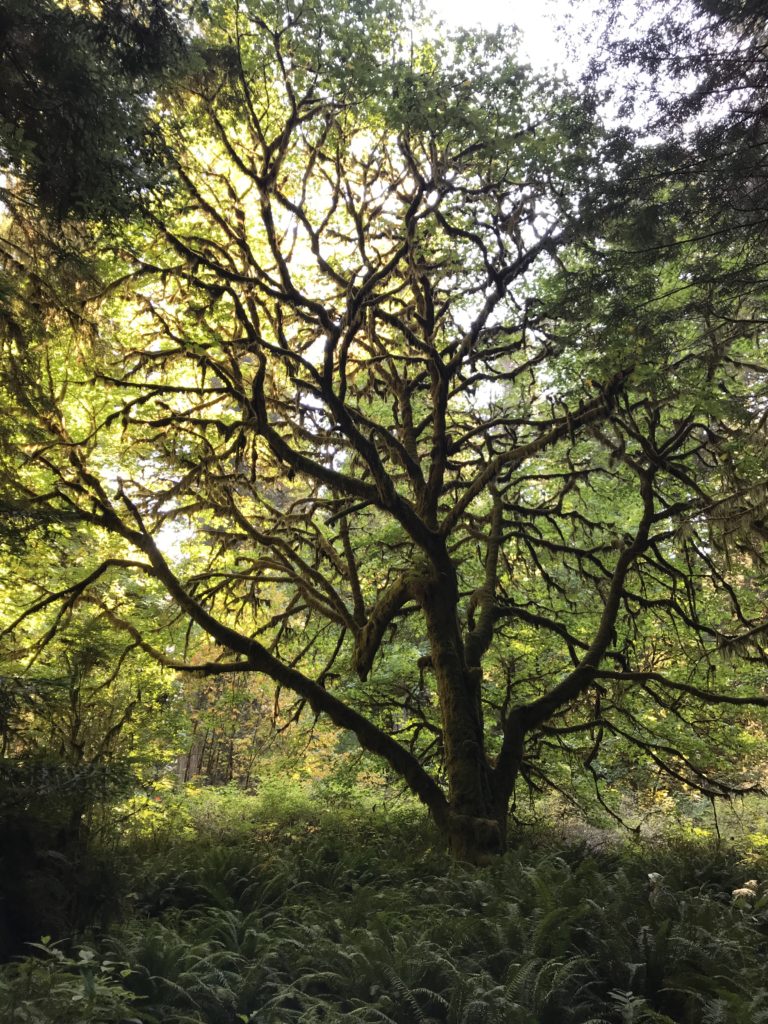
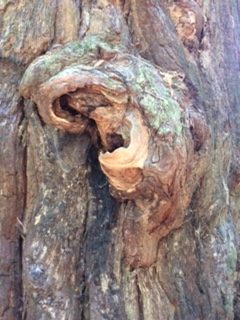
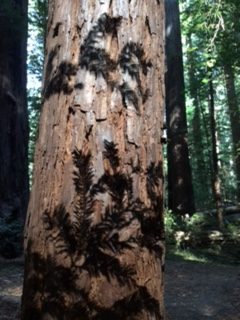
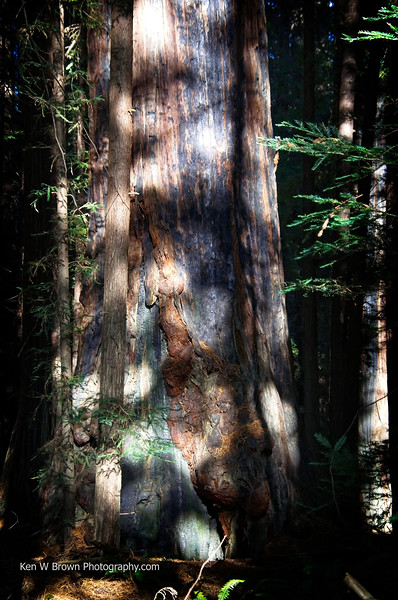
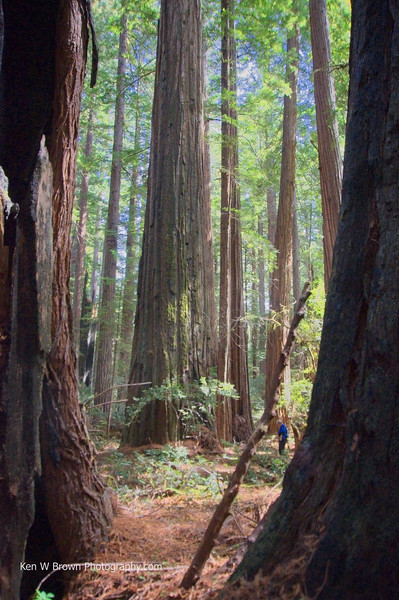
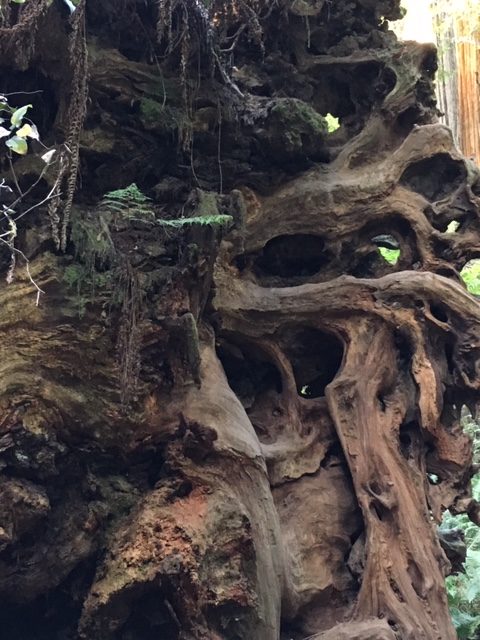
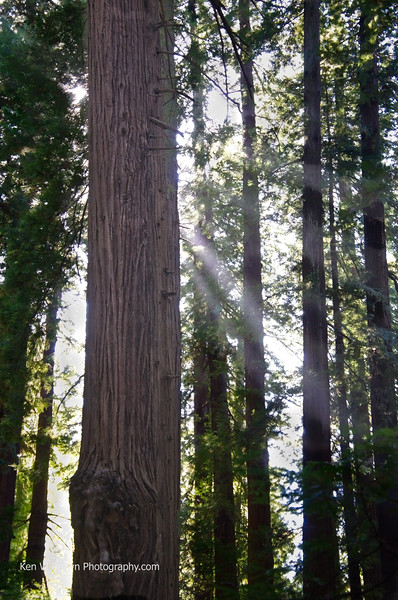




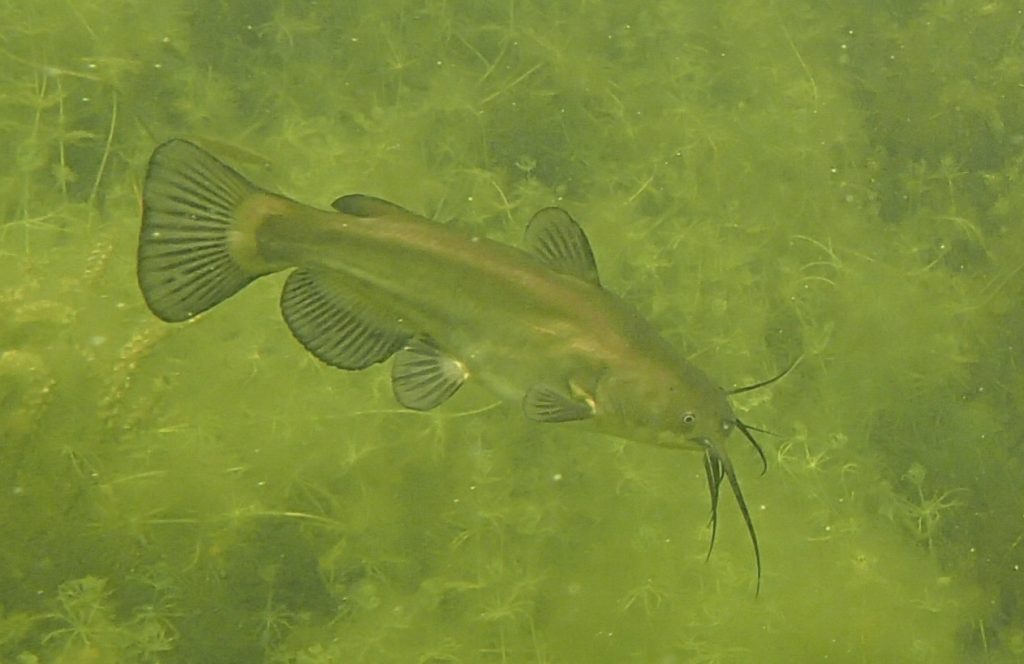
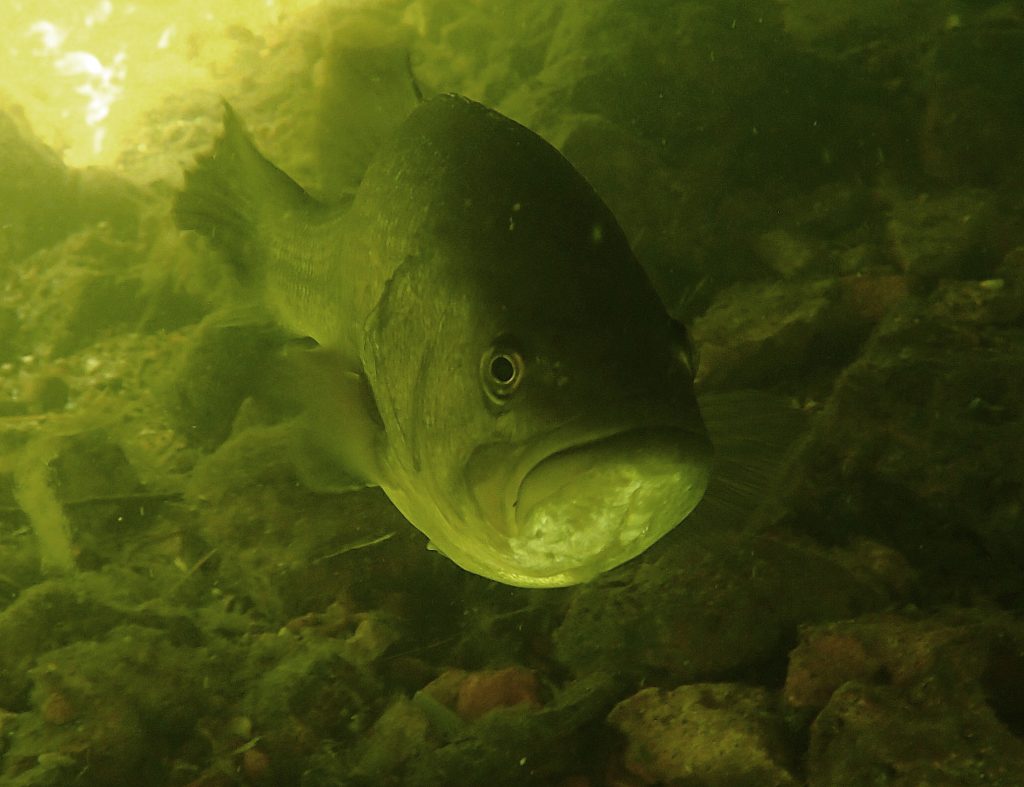
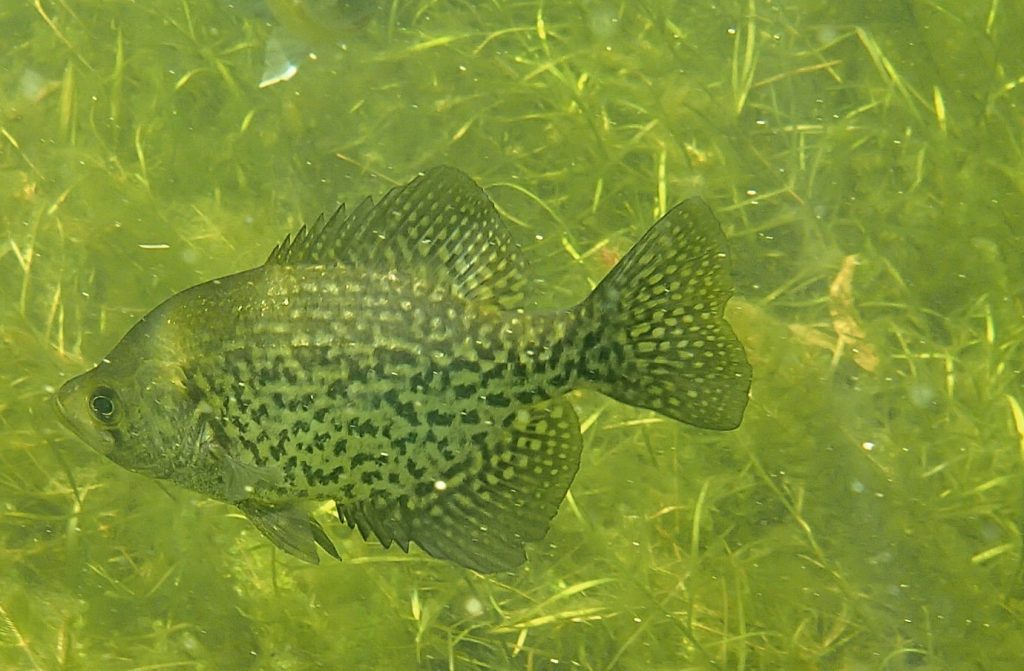
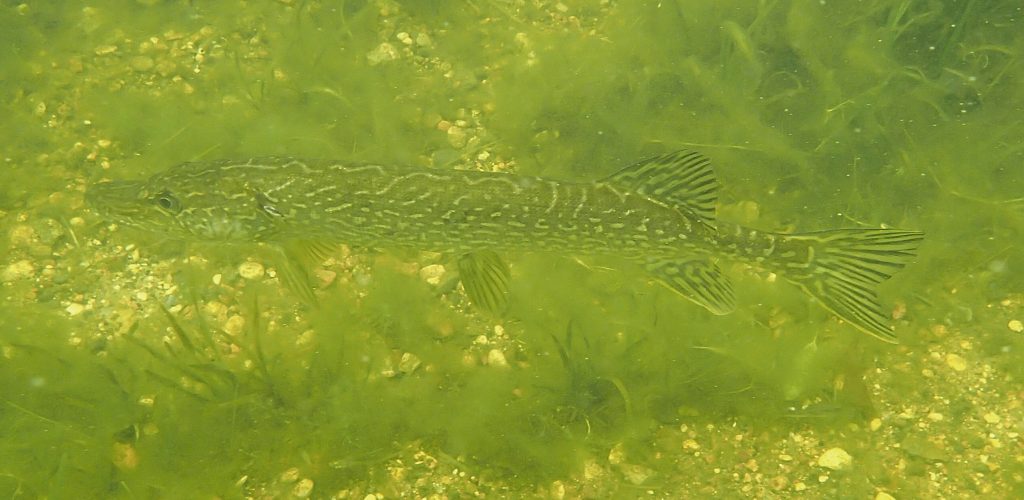
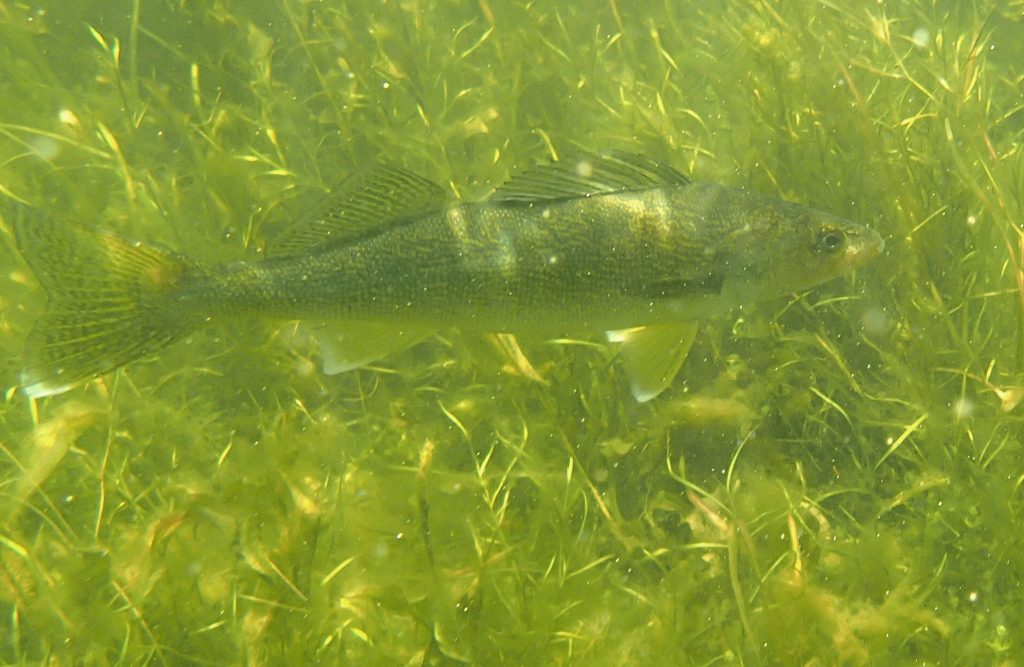
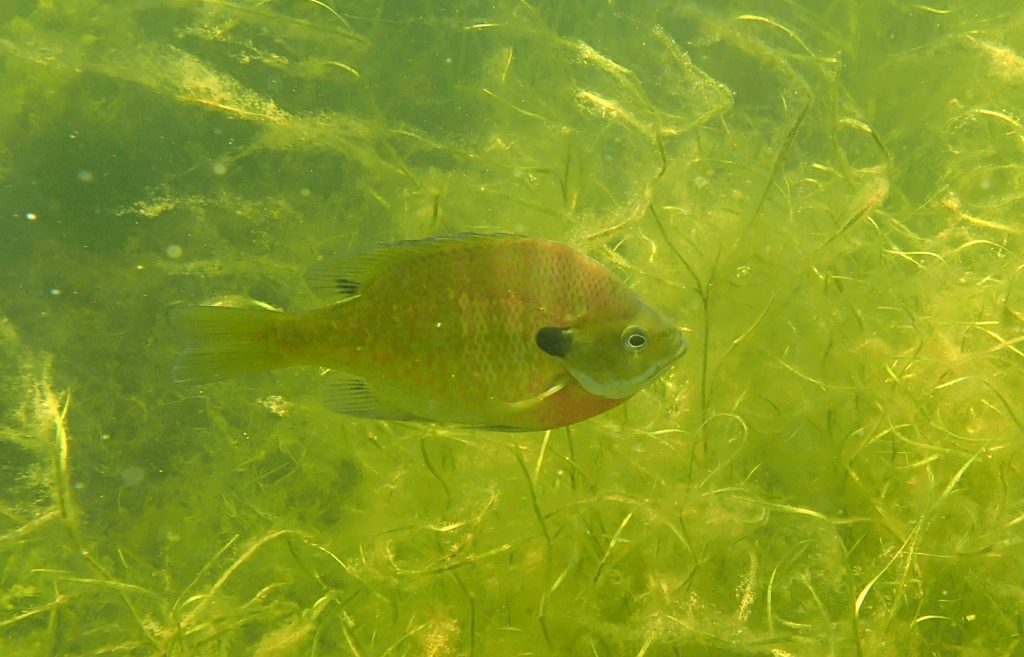
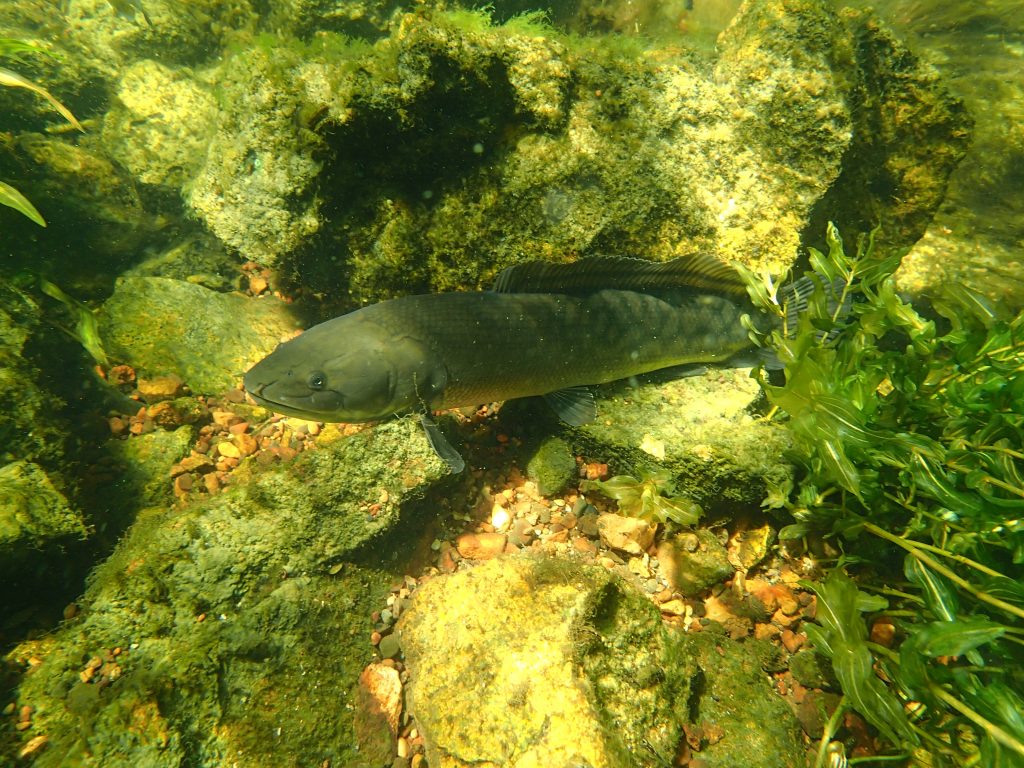
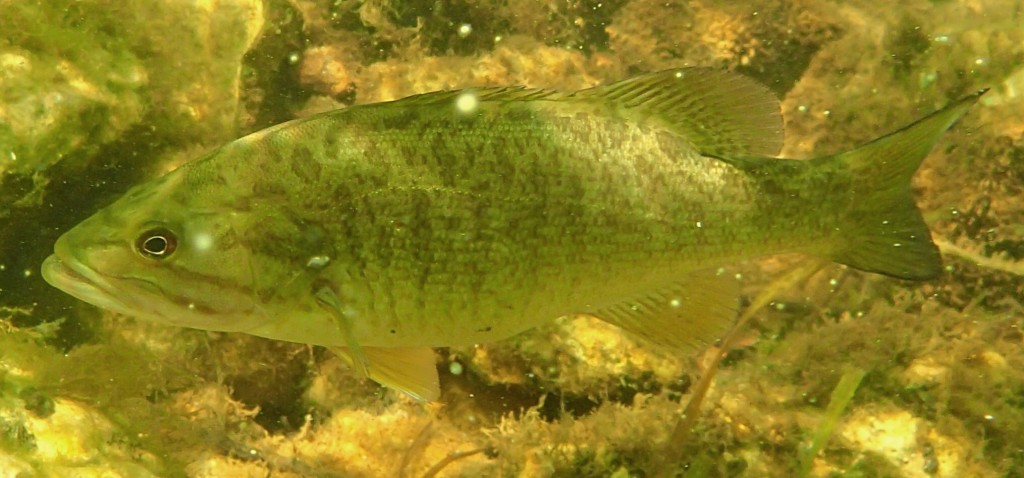
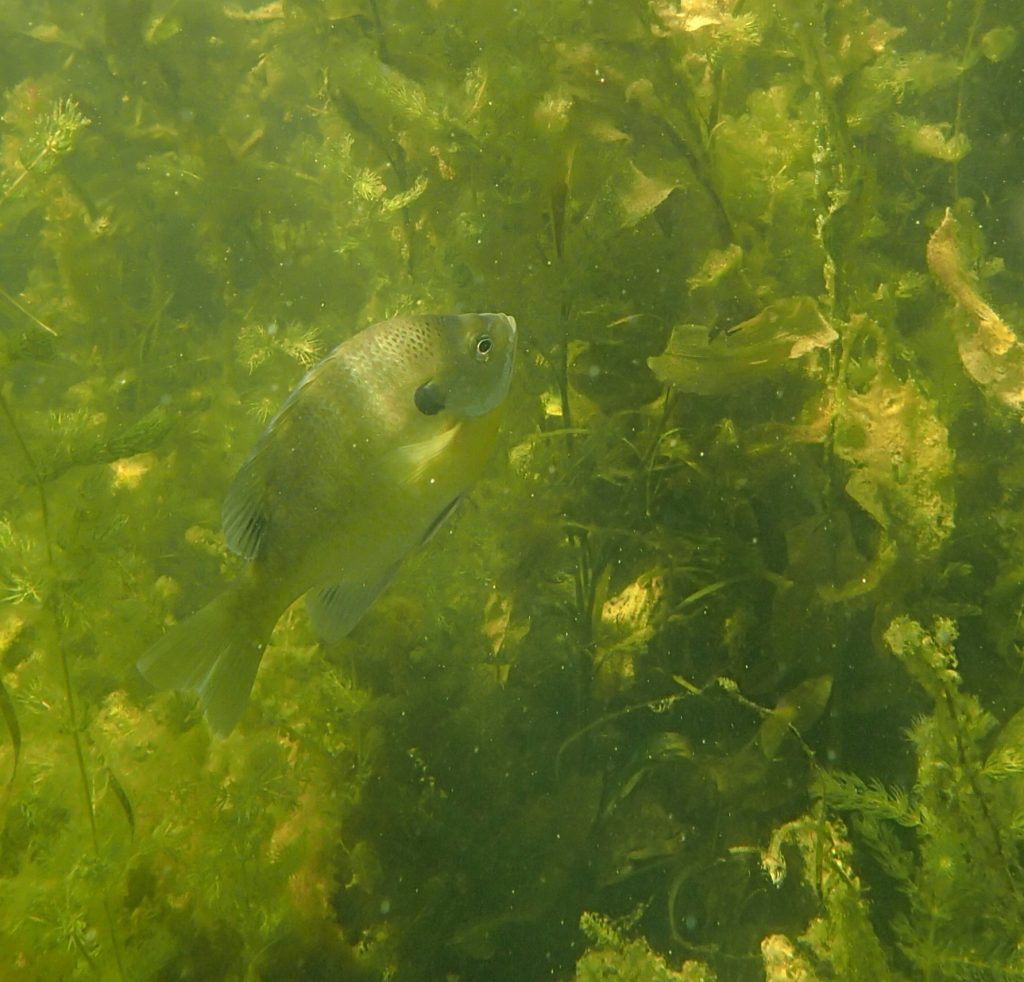
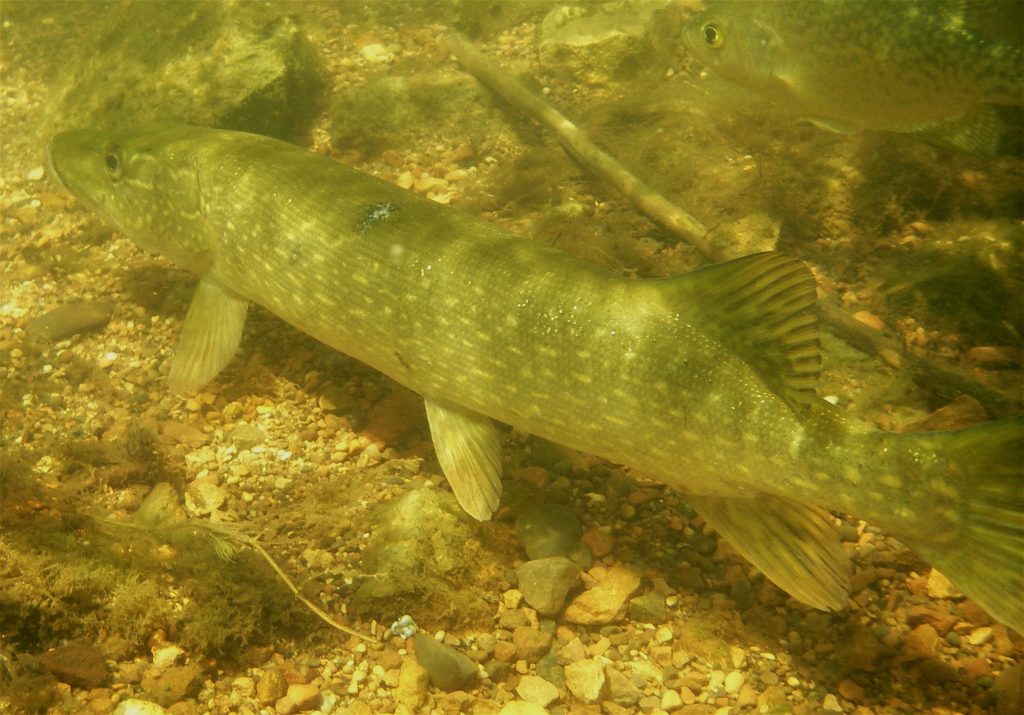
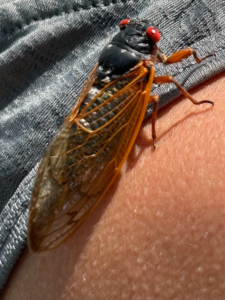
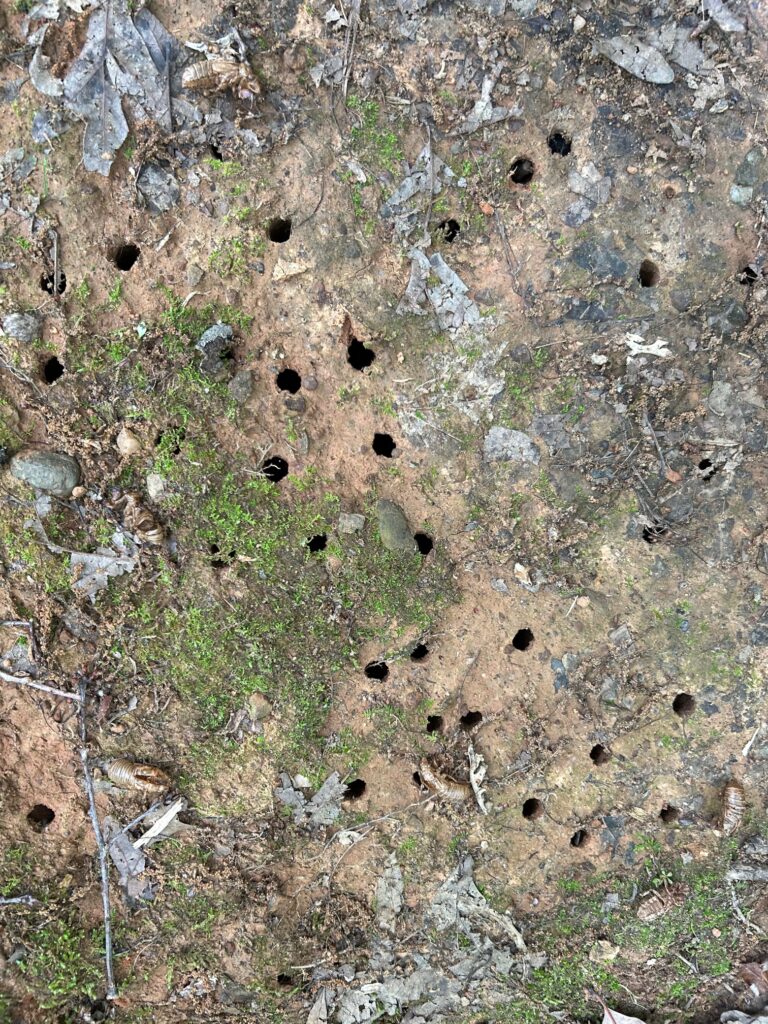

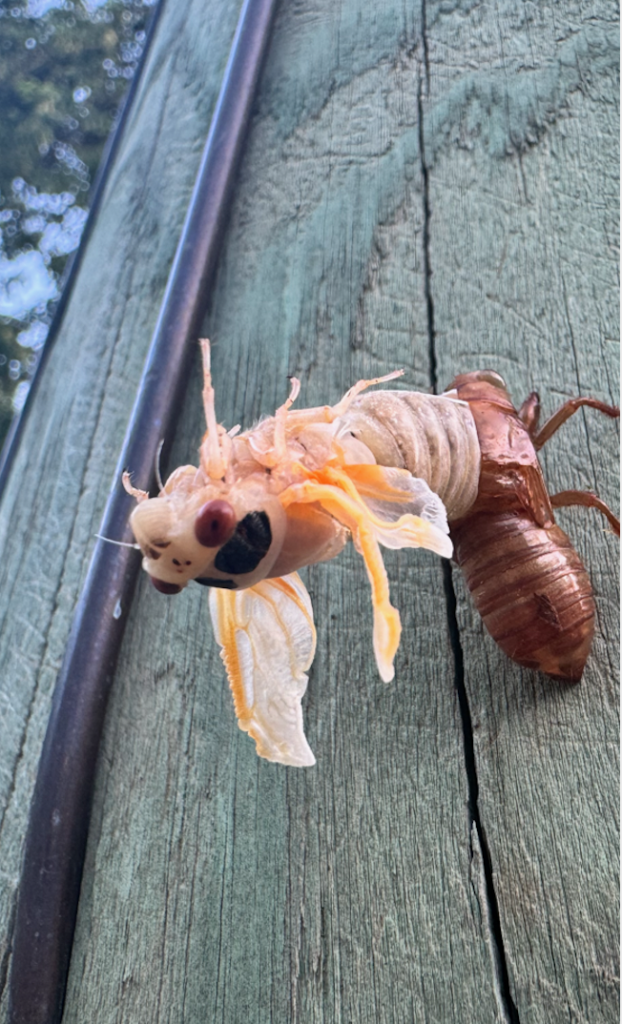
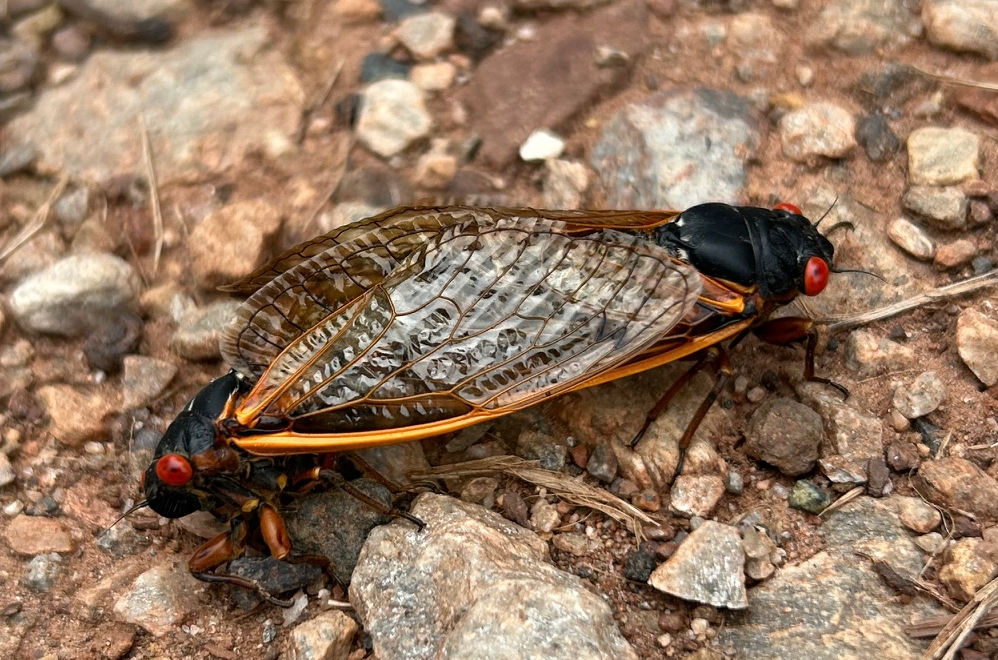
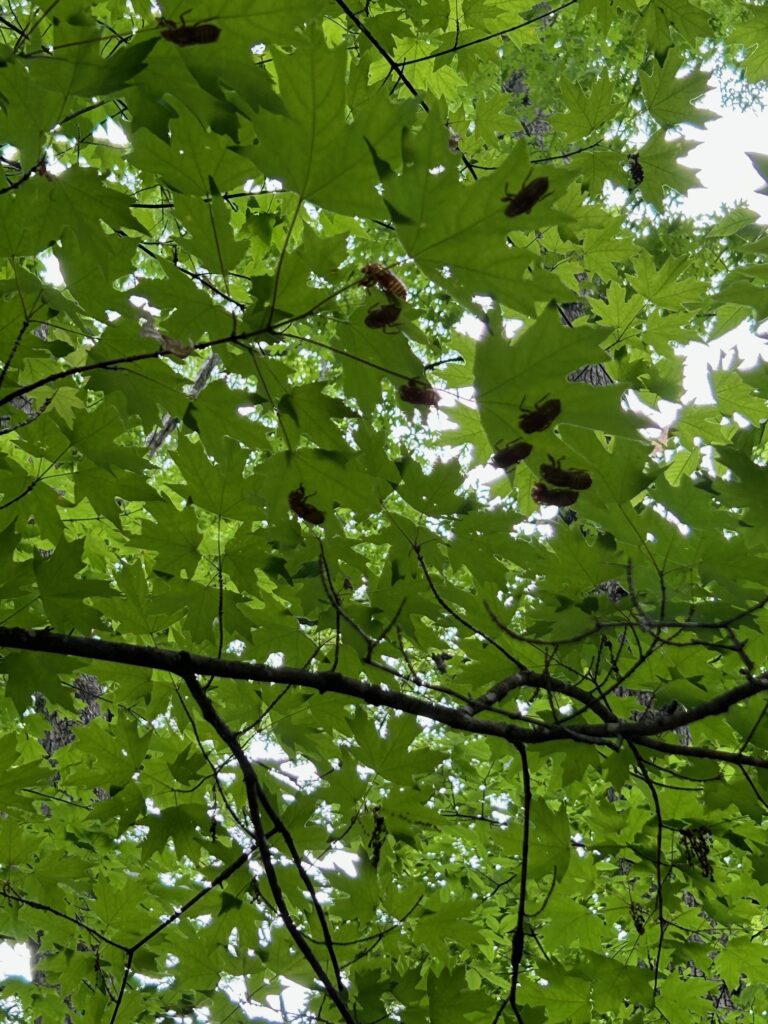
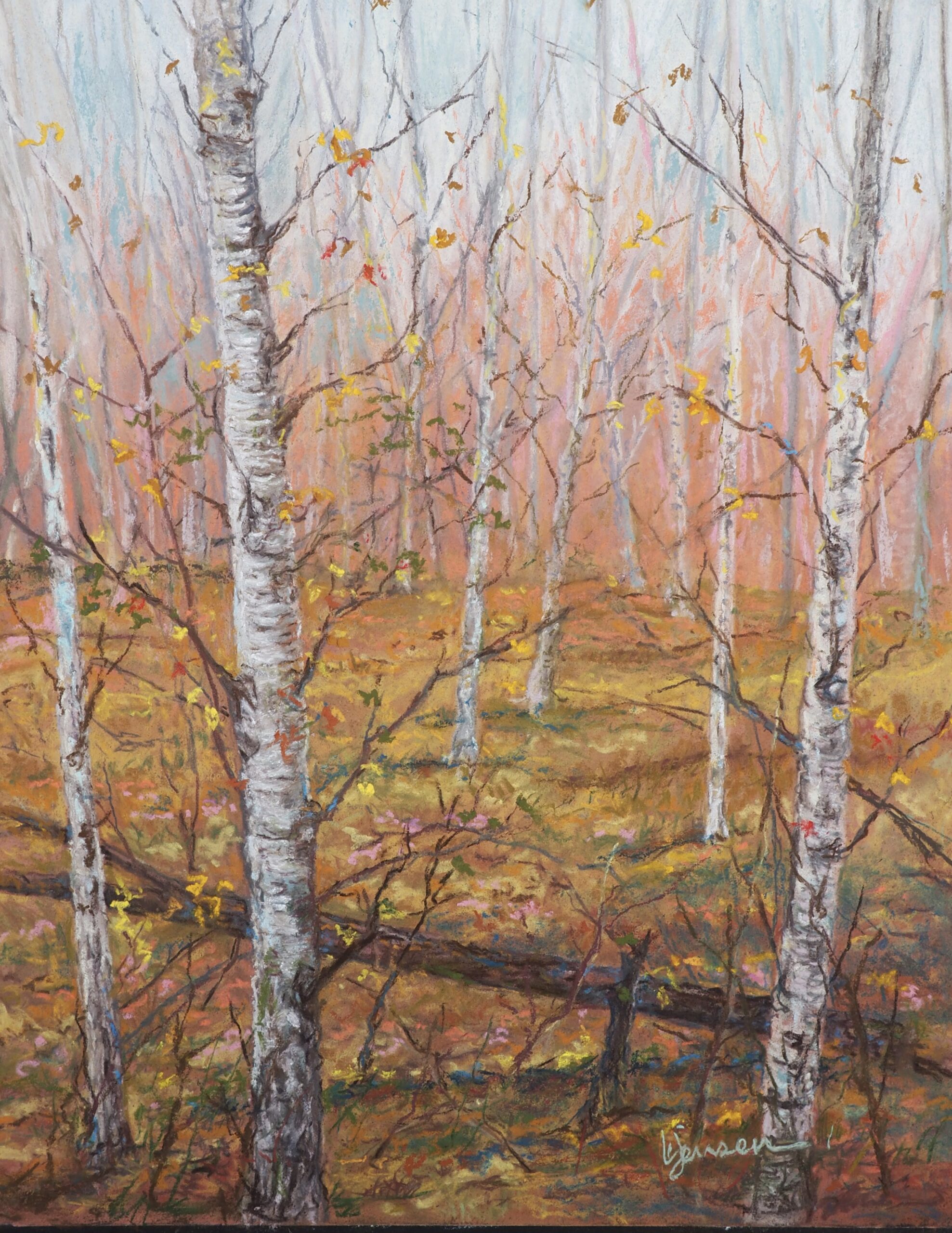
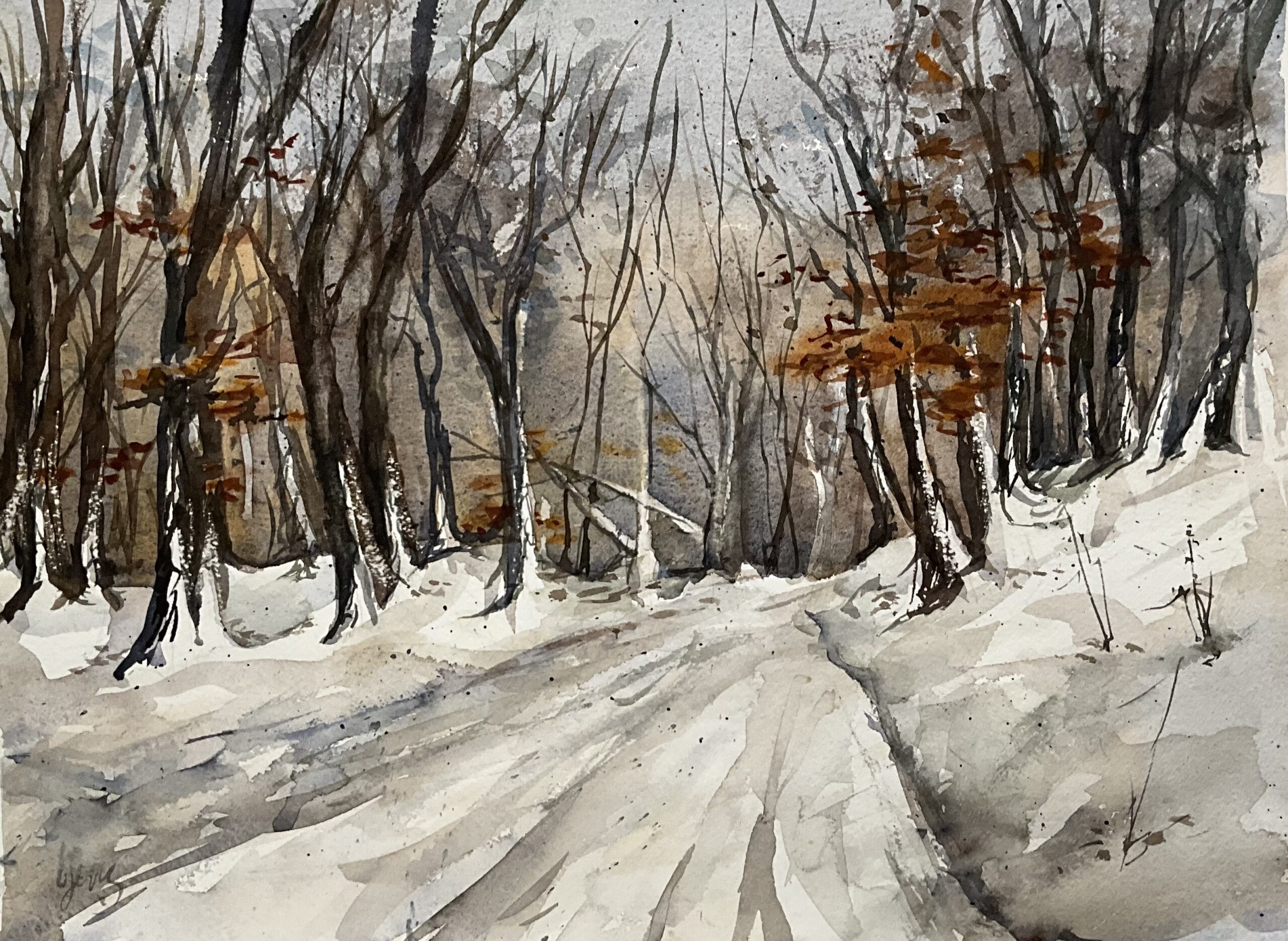
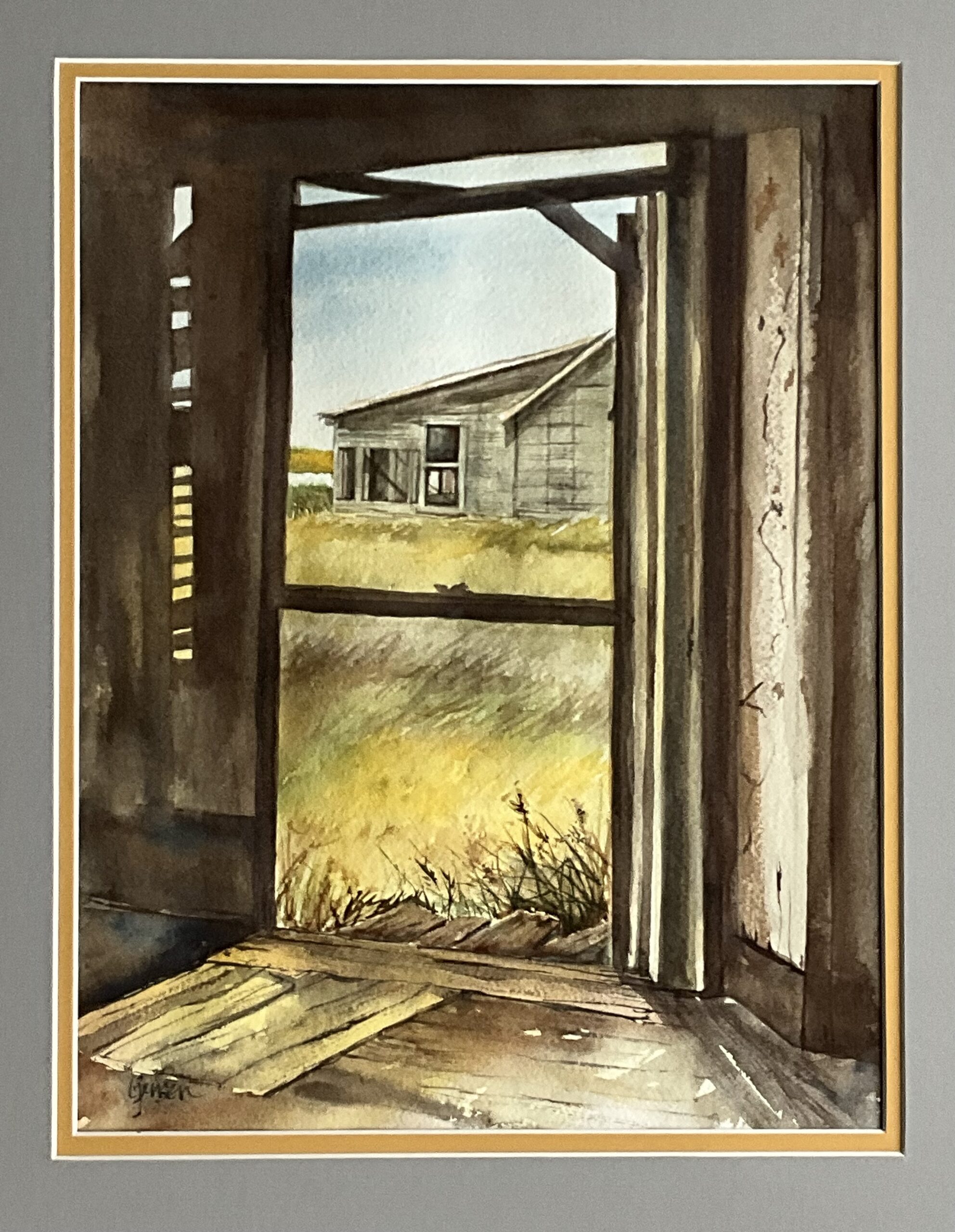
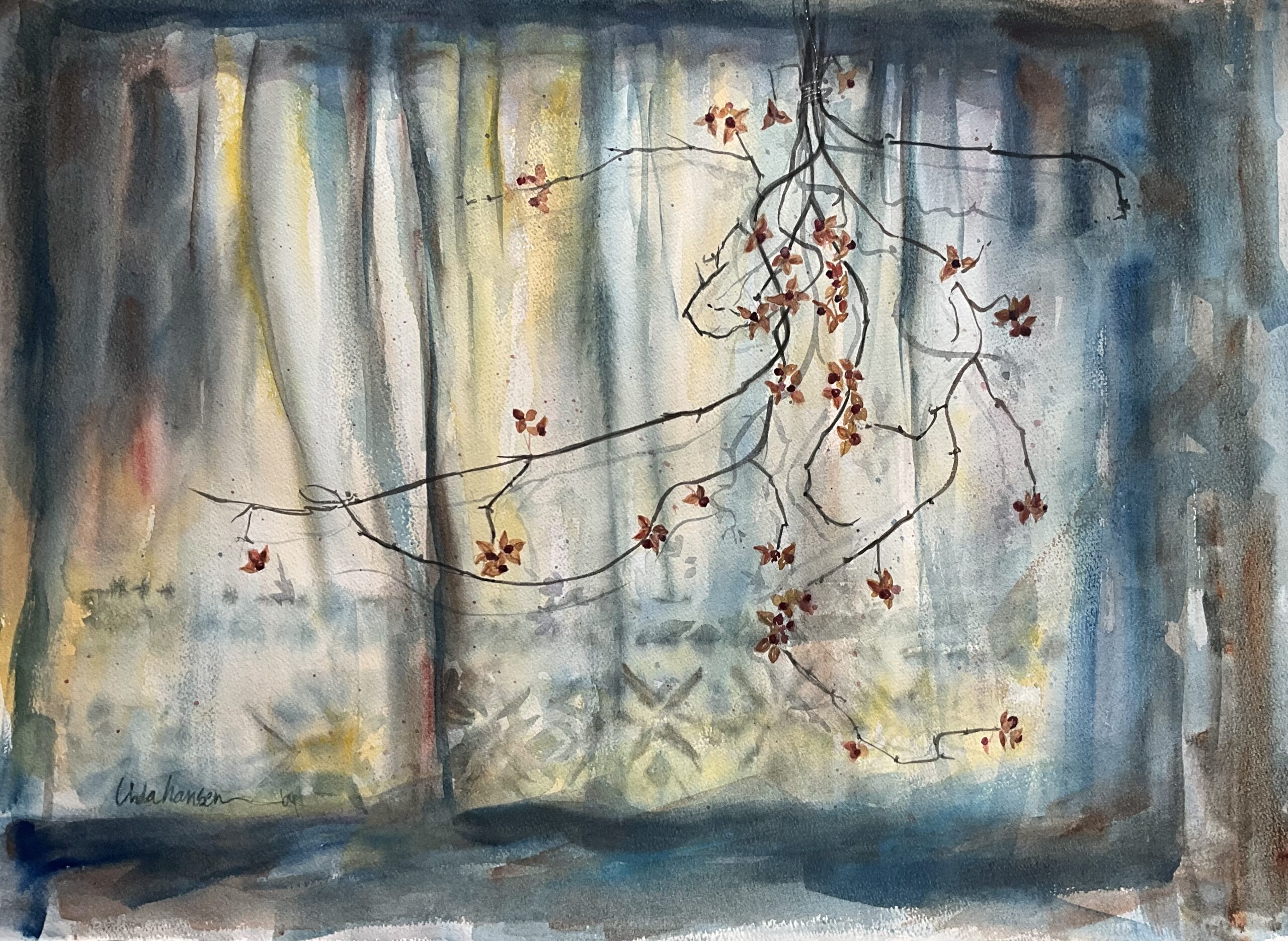
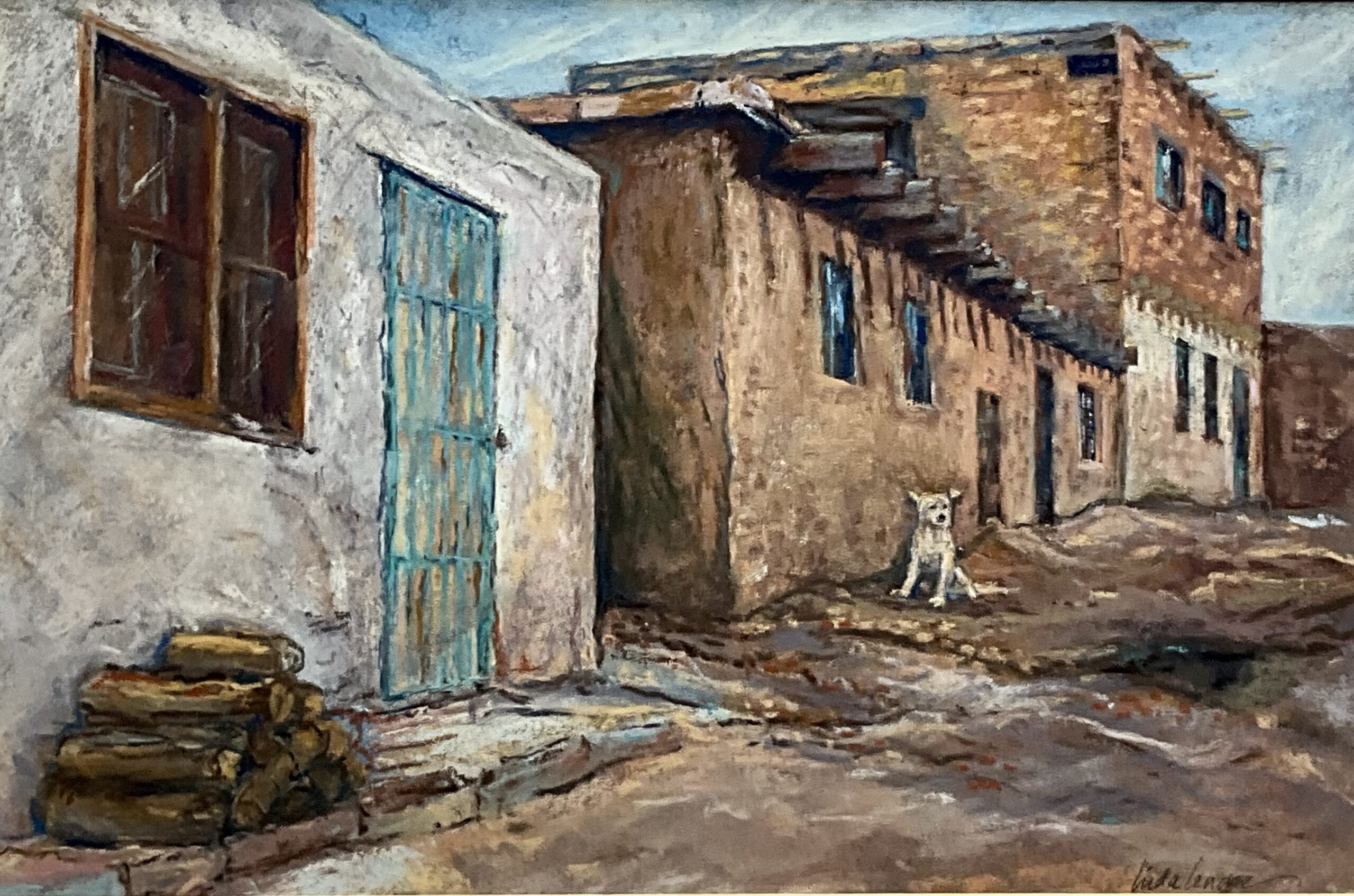
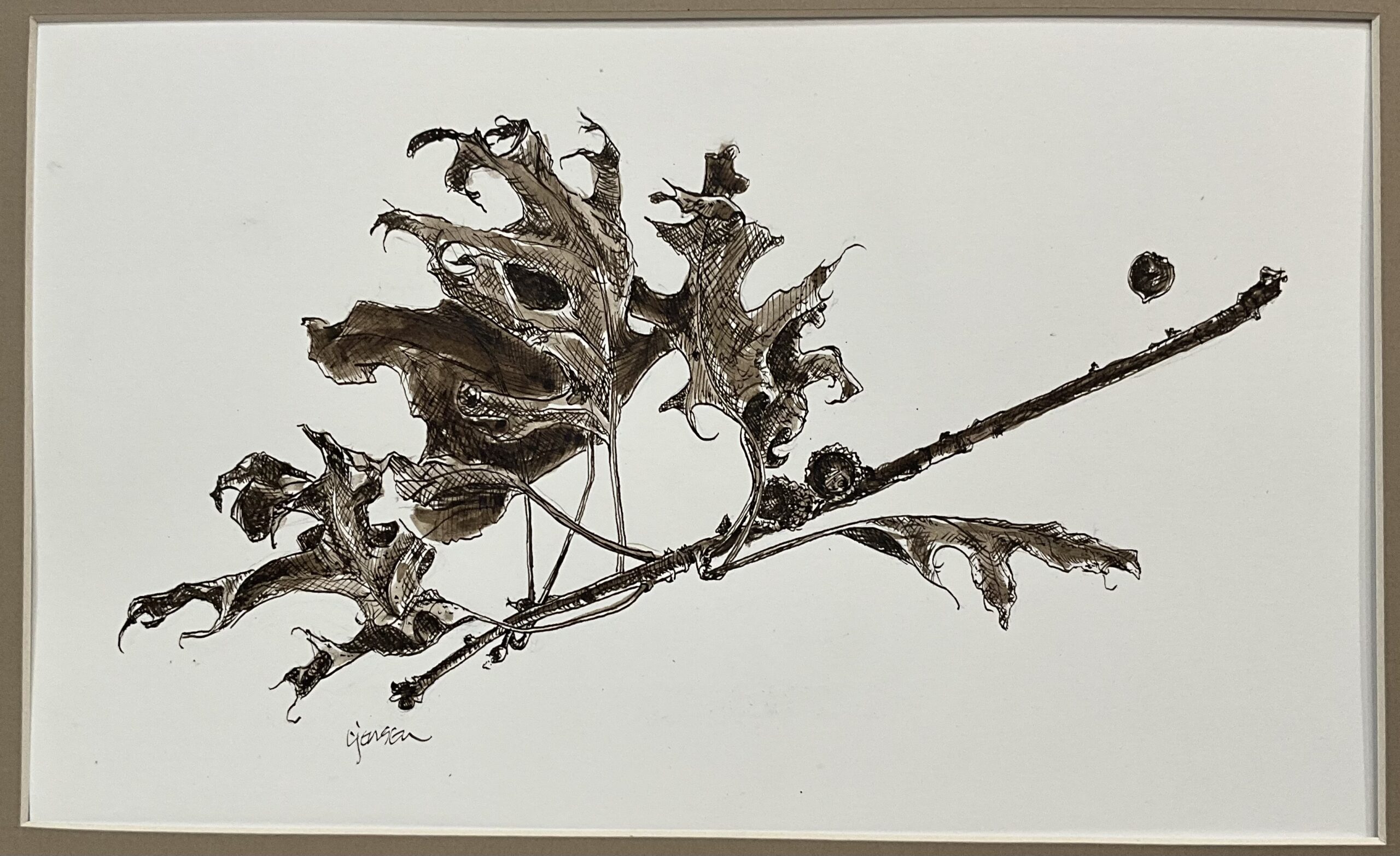
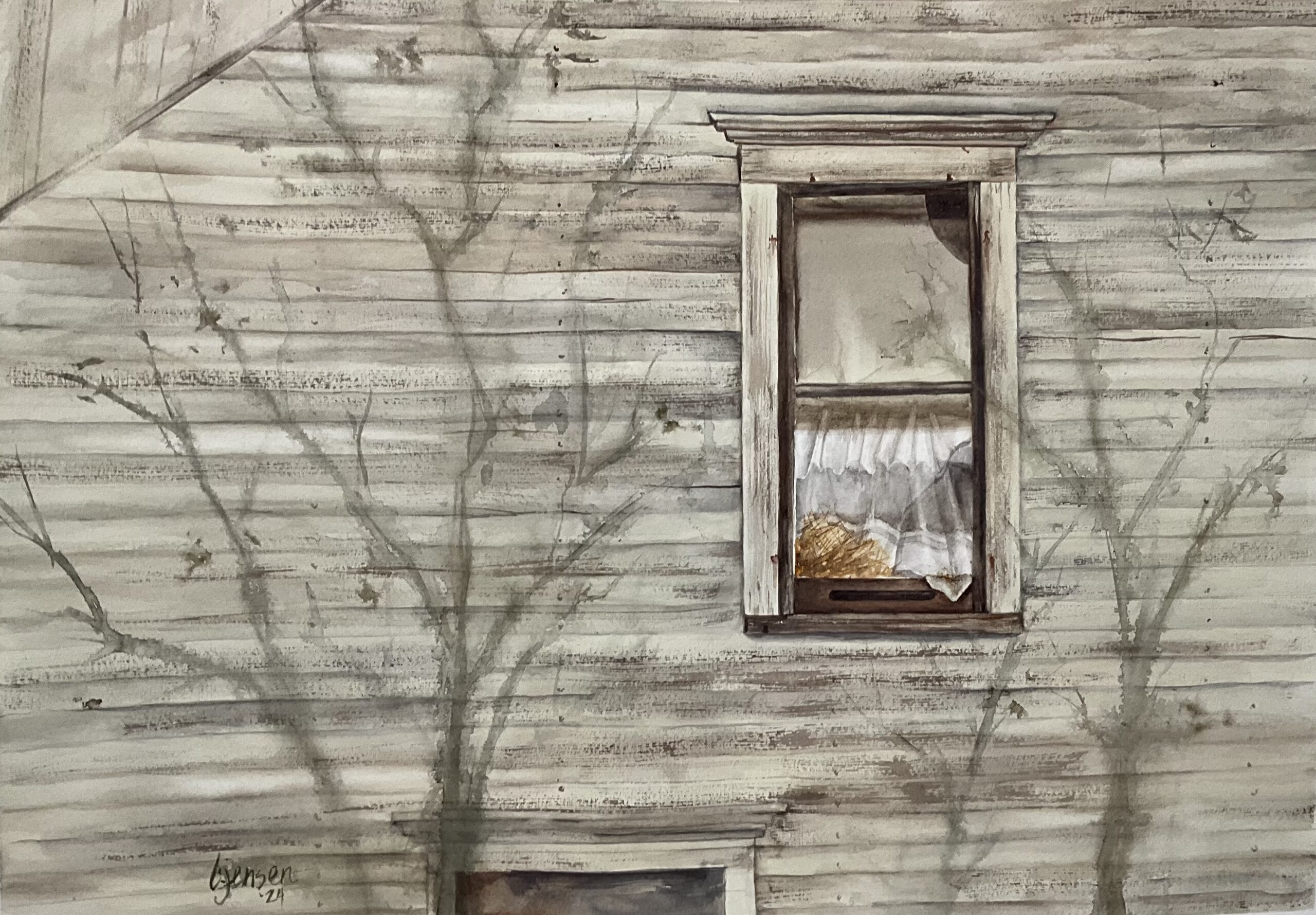
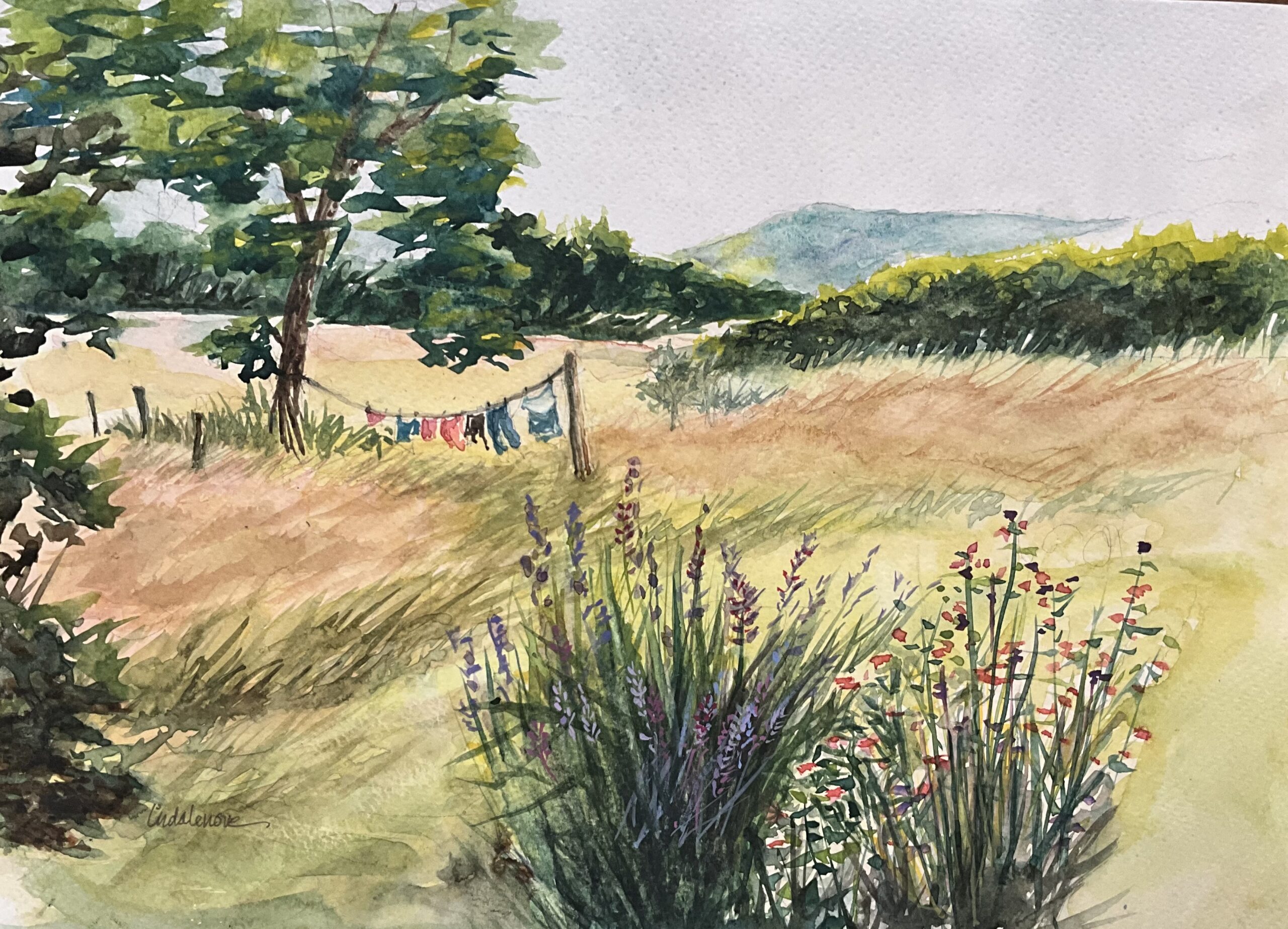
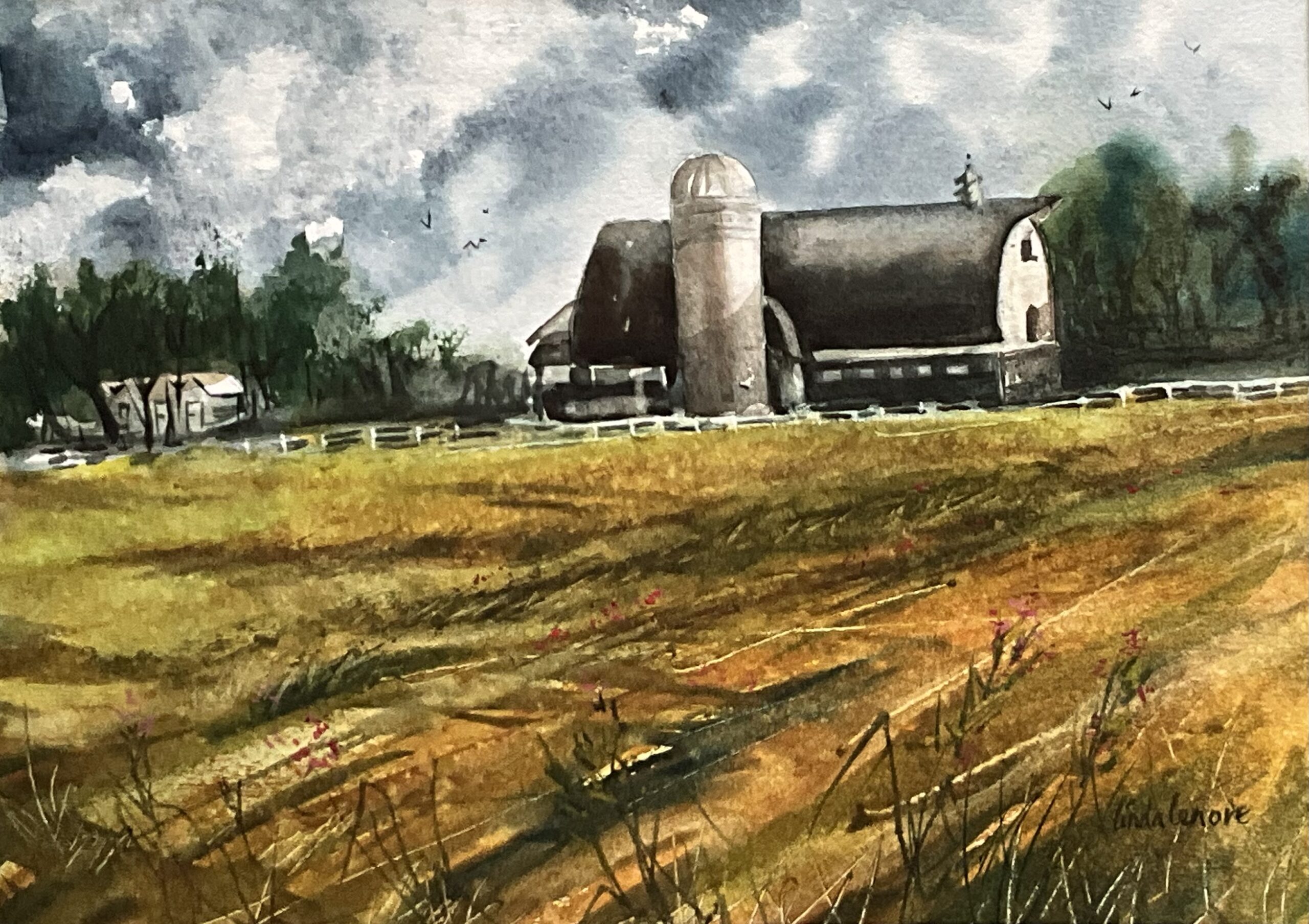
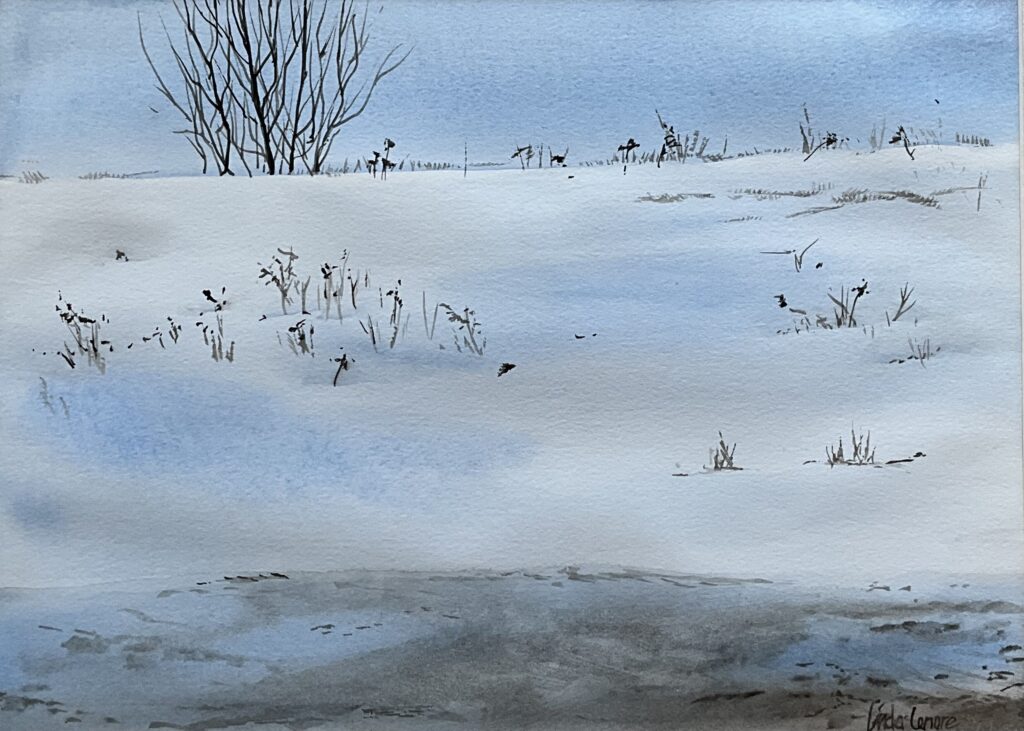
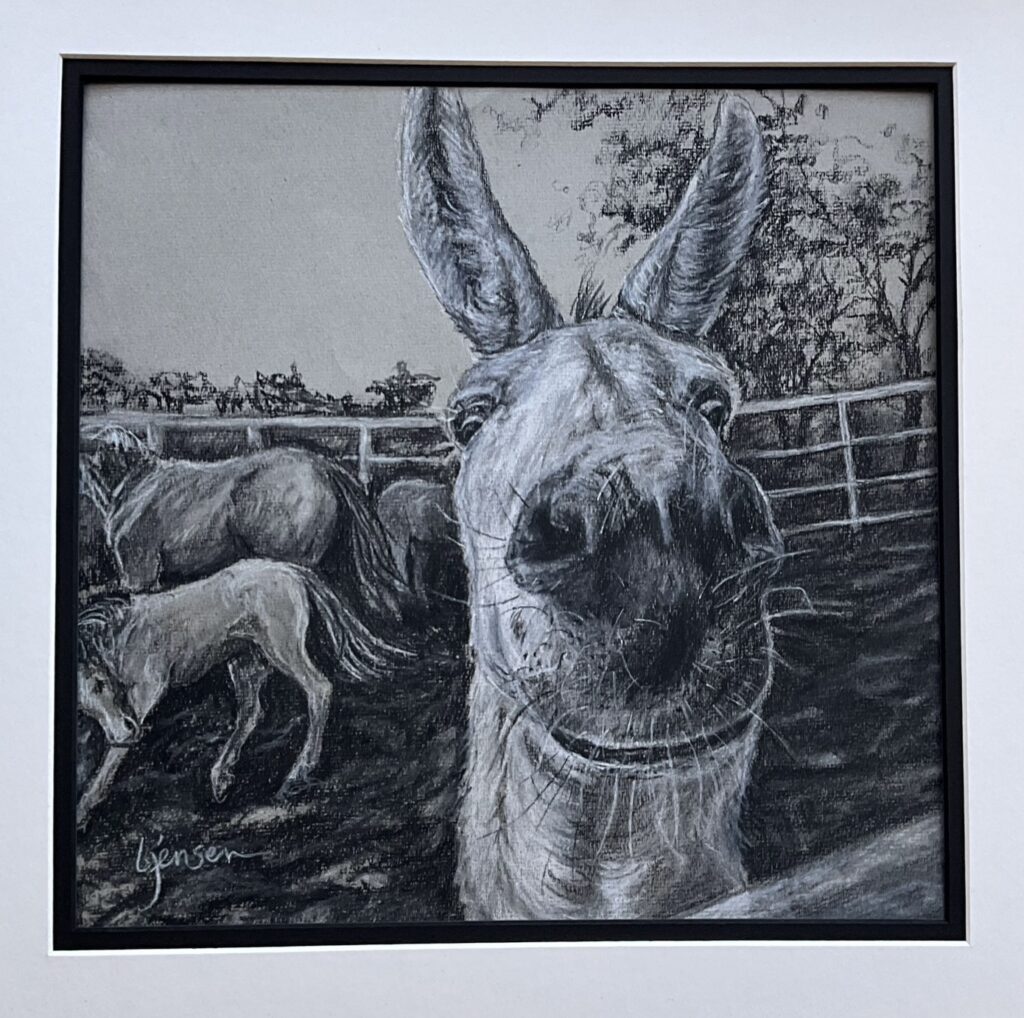
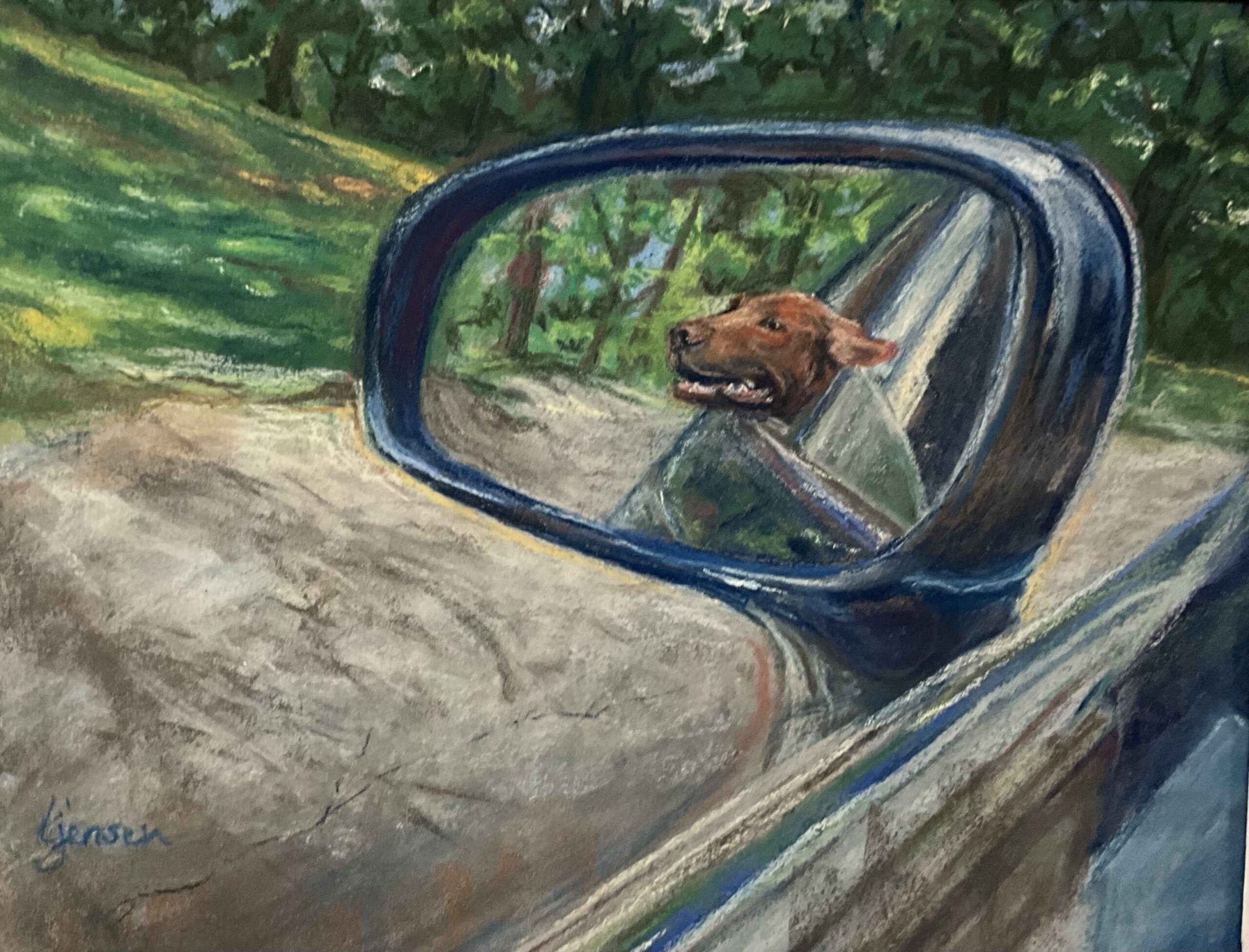
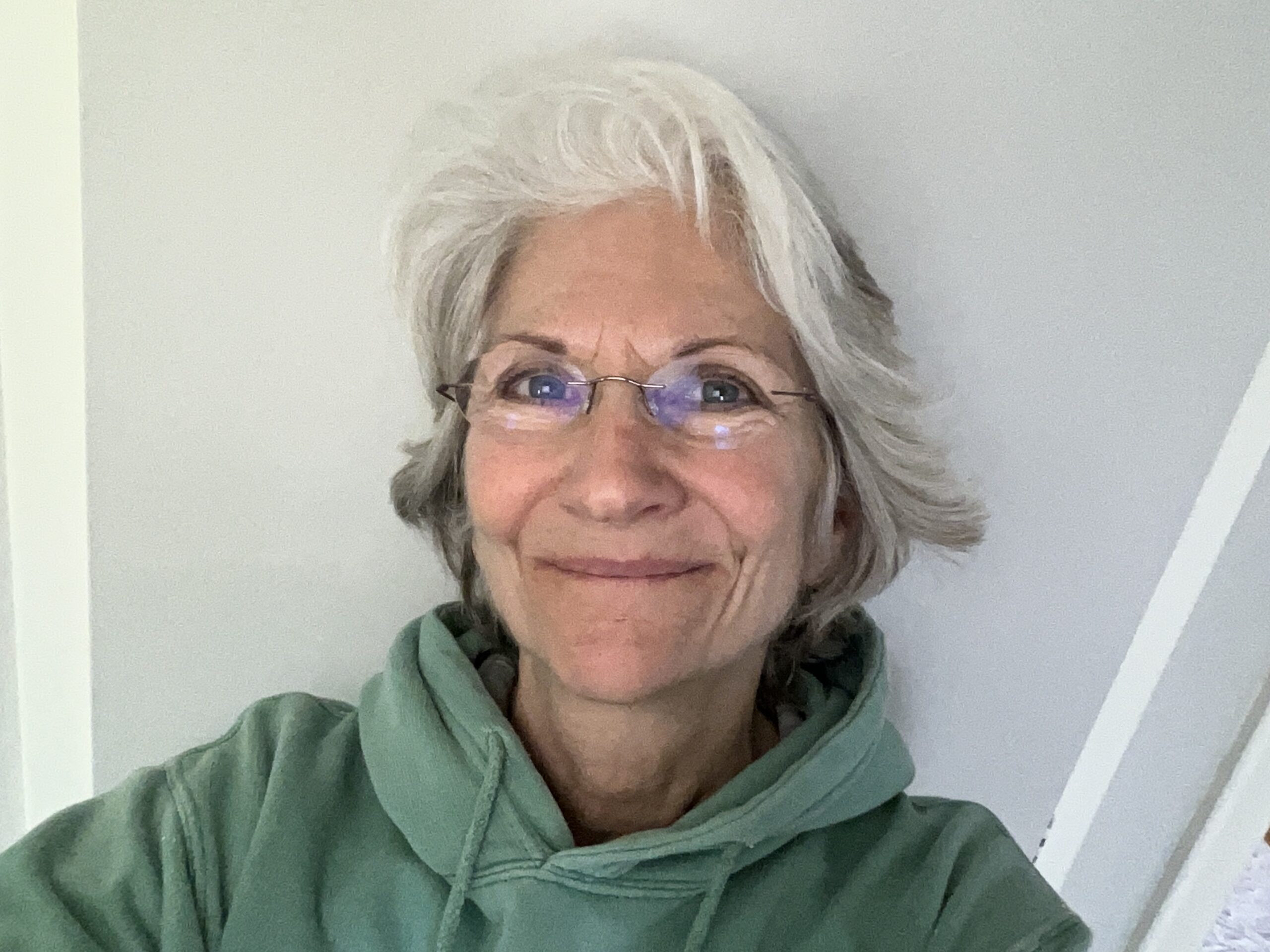
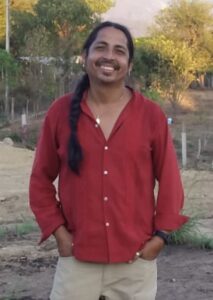

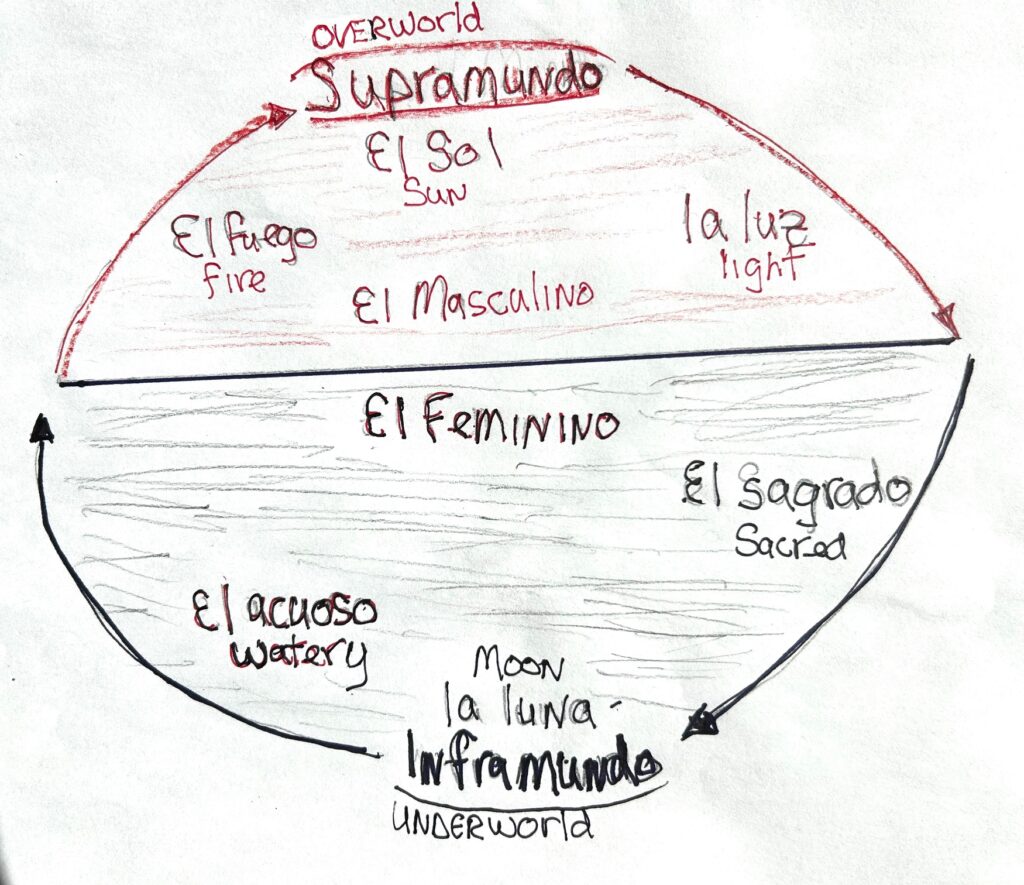
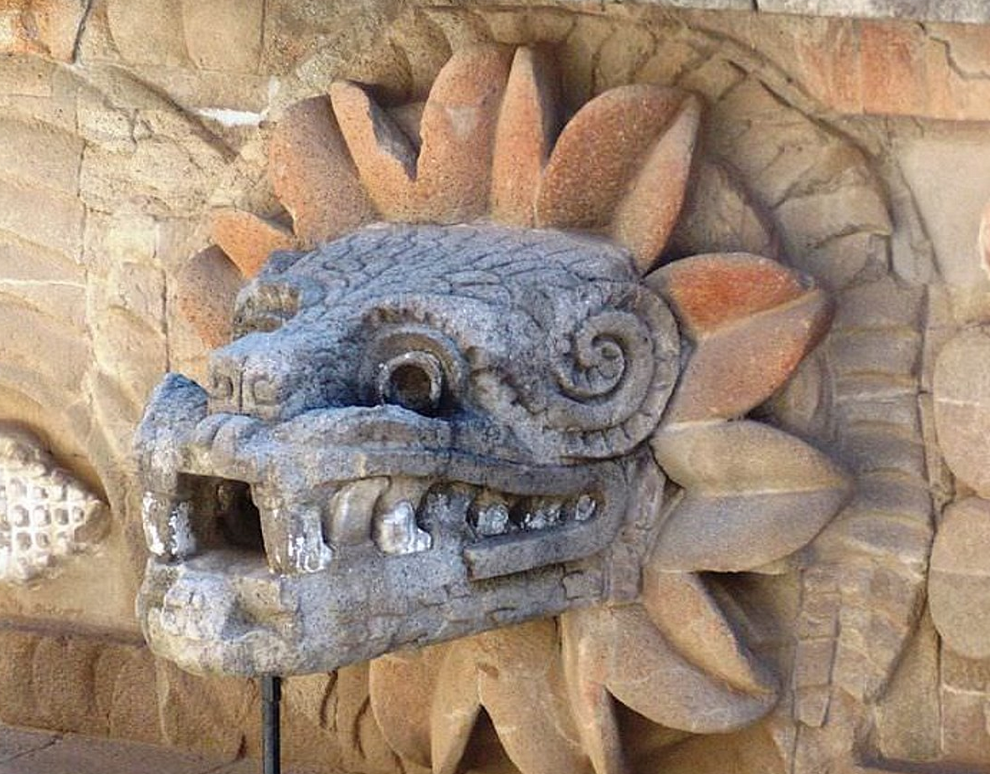
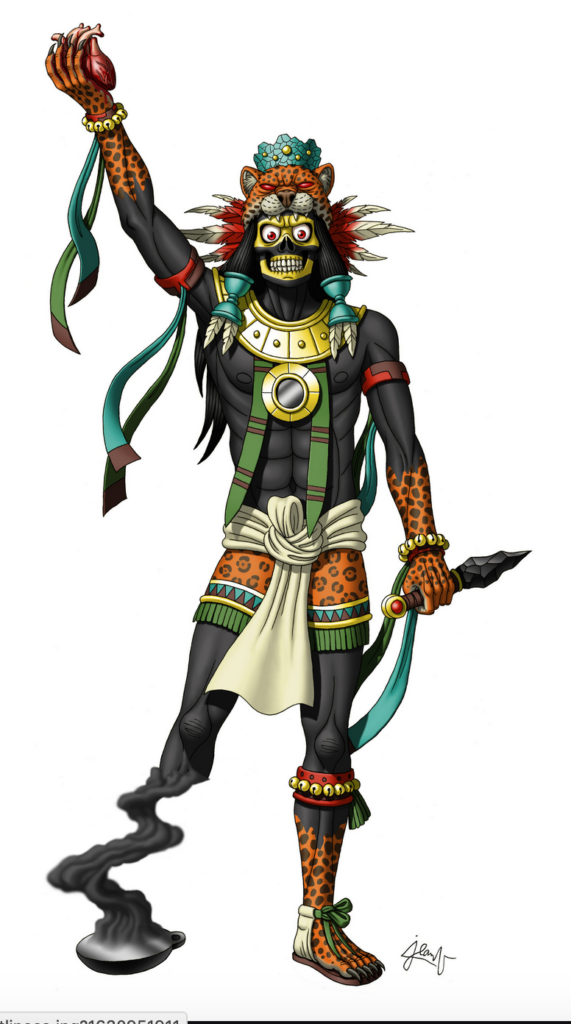
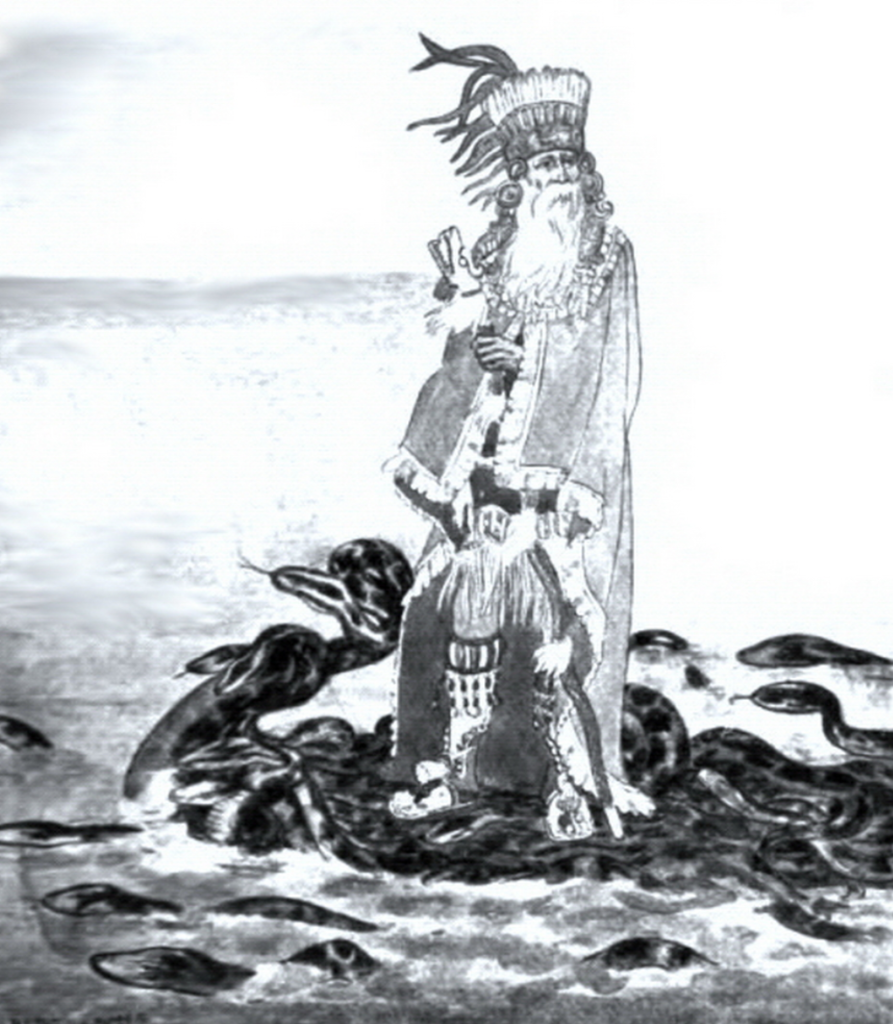












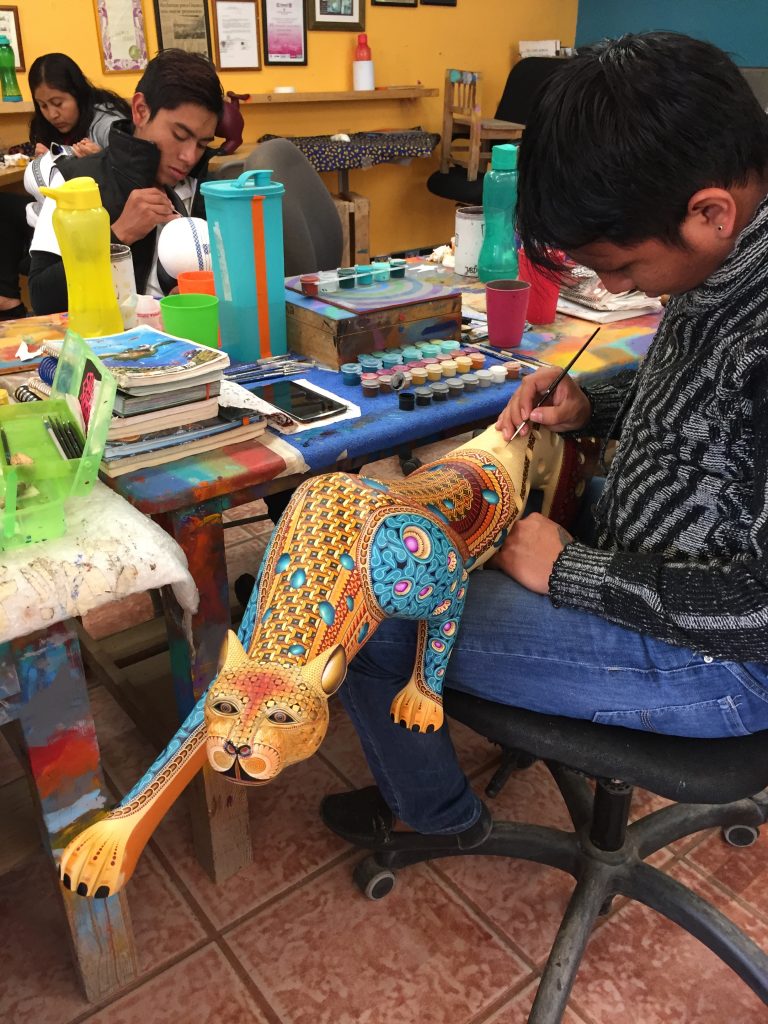








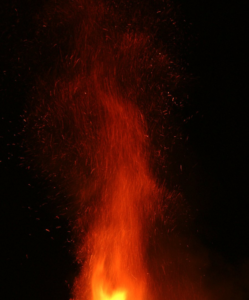
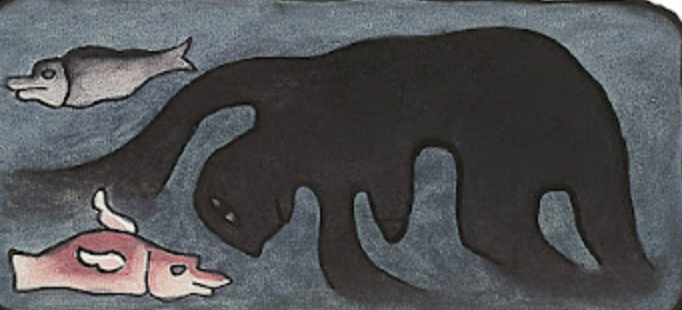
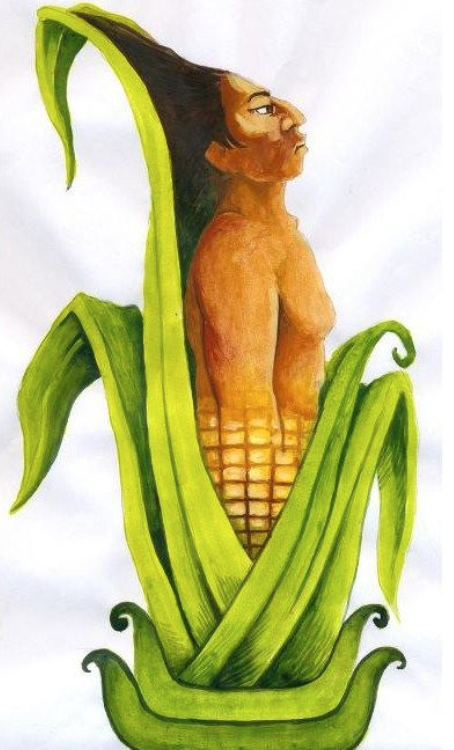
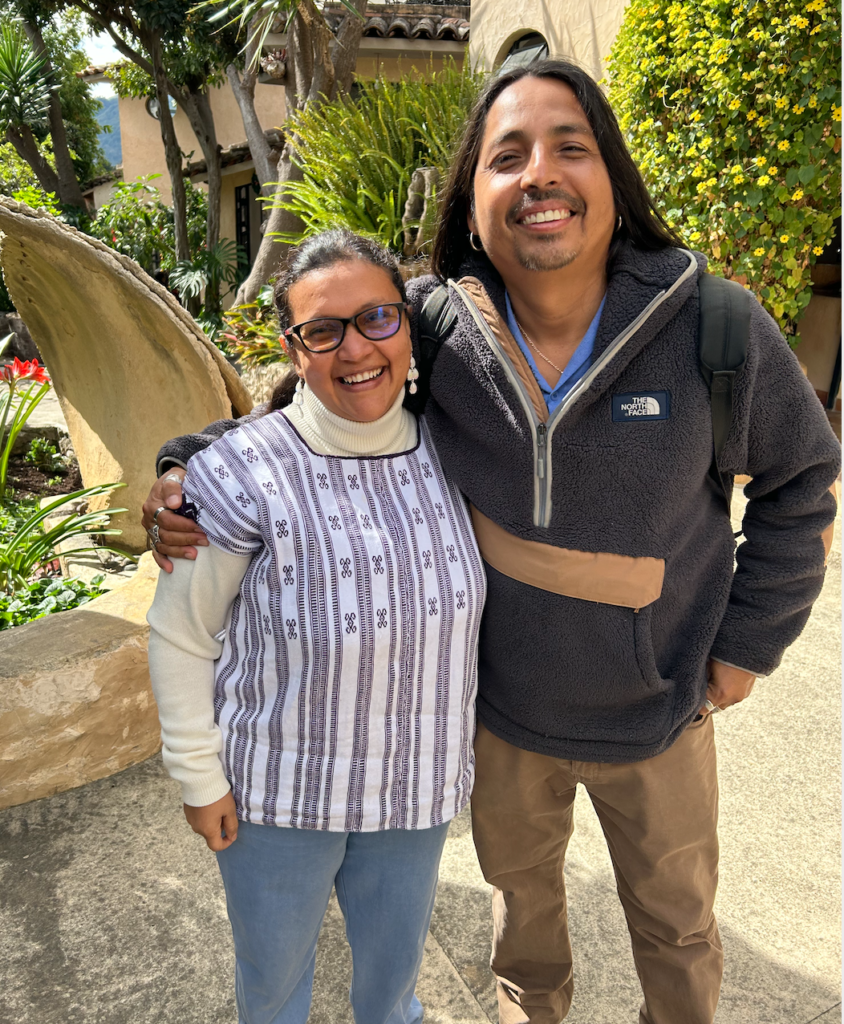
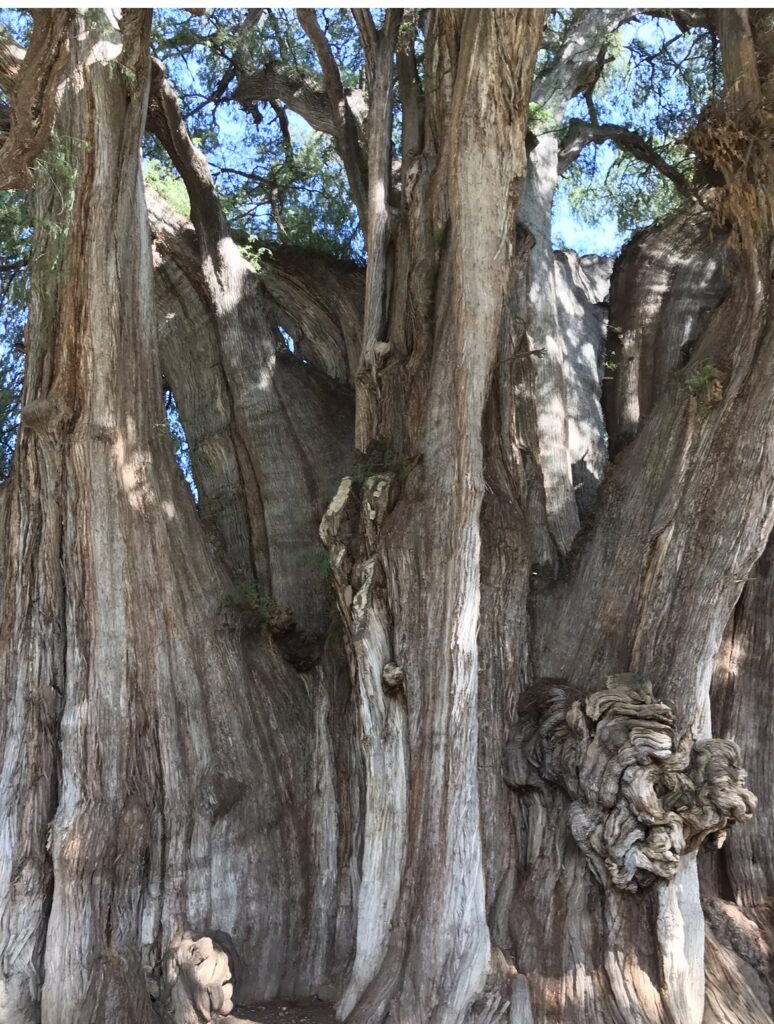
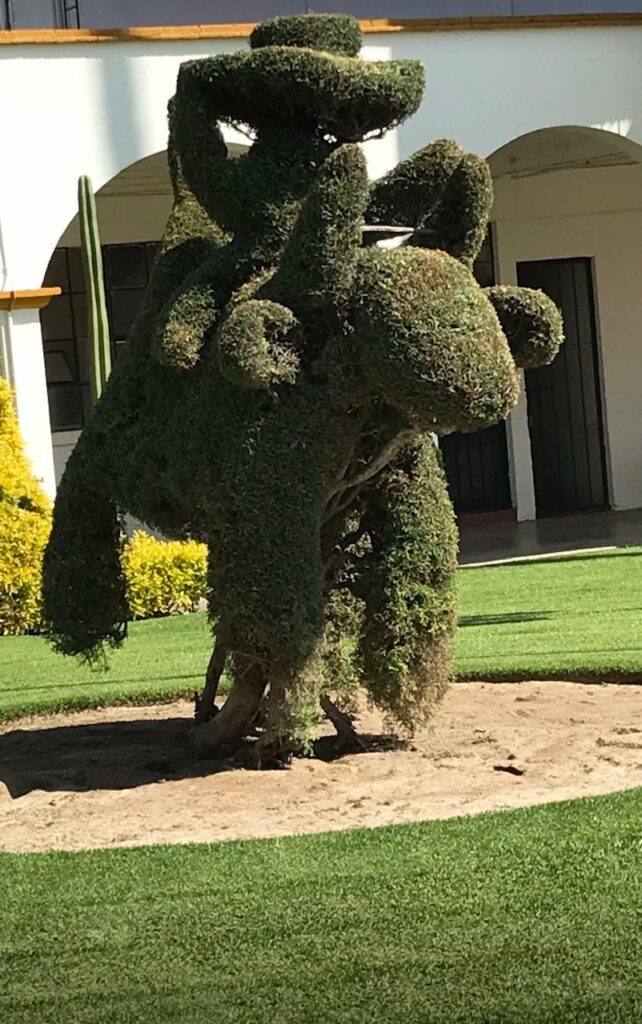
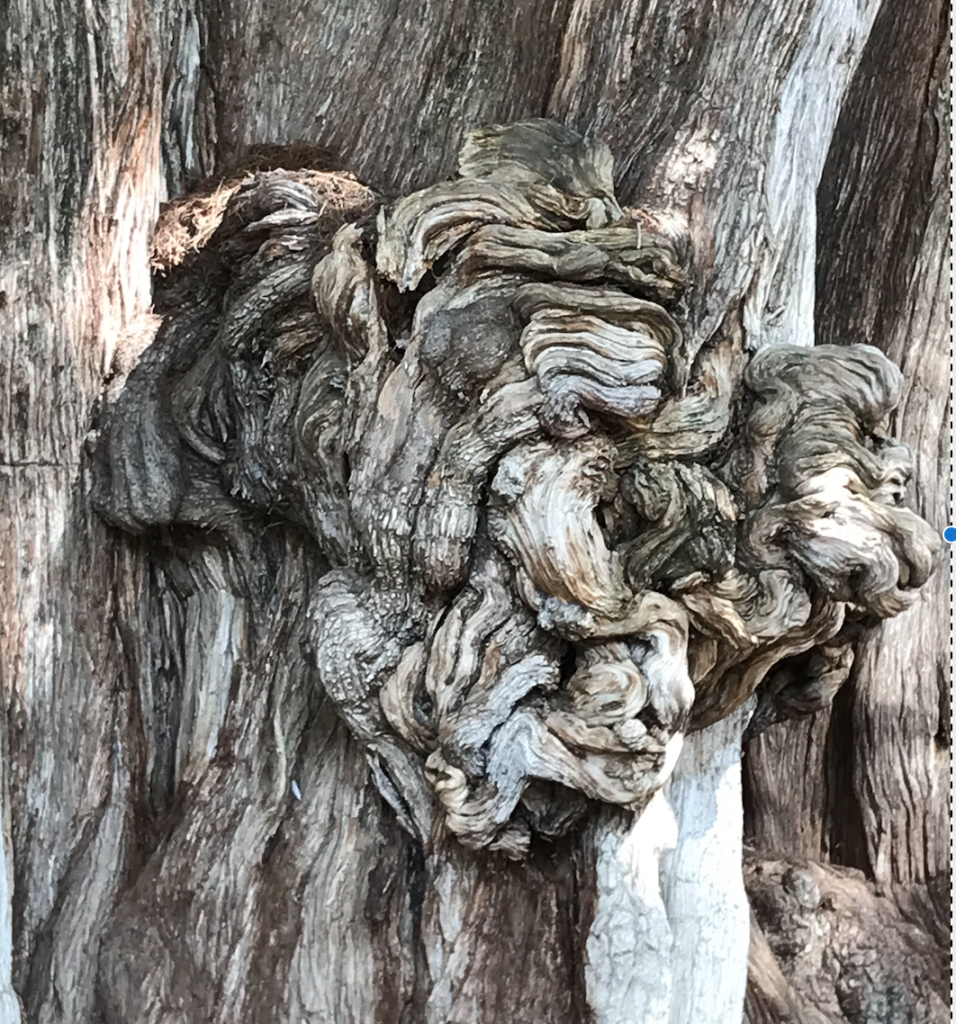



Breathing with the trees
Joining their breath.
I am with you and you with me,
woven together…humble, patient
Be
Barbara Goodman-Fischtrom
Photo by Barbara Goodman-Fischtrom
Sunlight through the Redwoods
Photo by Annie Kitaeff